US tourists warned about popular Mexico spots plagued by drug cartel intimidation, violence
- Increasing threats of violence pervading Mexico have made their way to popular tourist spots.
- State Department officials issued a warning of a heightened risk of violence to Americans.
- Tourists are an easy target for drug cartels, analysts say, particularly if they’ve come to sample the drug scene.
TULUM, Mexico – With its turquoise waters, white sand and ancient ruins, this city has become an increasingly popular spot for tourists seeking a getaway along the Caribbean coast.
Its raves, nightclubs and exclusive resorts and restaurants offer a more tranquil getaway than Cancun, its more well-known neighbor 81 miles to the north.
But the increasing threats of violence pervading Mexico have made their way here, as well as the surrounding state of Quintana Roo. State Department officials issued a warning Aug. 17 of a heightened risk of violence to Americans traveling there.
While the U.S. government has no restrictions on travel for its employees in Quintana Roo’s tourist sites, such as Cancun, Cozumel and Tulum, it is warning Americans to “exercise increased caution due to crime and kidnapping.”
Tourists are warned to “remain in well-lit pedestrian streets and tourist zones” in the wake of shootings between rival cartels that have injured bystanders.
US travelers warned of 'kidnapping risk' in some parts of Mexico
Travel safety: 17 CIA tips on how to think like a spy and stay safe while on vacation
In October, two tourists were killed while having dinner at an outdoor restaurant in Tulum. A month later, guests at a resort in Puerto Morelos were forced to hide while gunmen arrived by boat and killed two.
And in January, two Canadian tourists were killed at a luxury hotel in Playa del Carmen the same month the manager of a popular beach club was murdered in a restroom by two men who fled on a watercraft.
The cartels’ influence in the region has risen as “tourism began to grow, and as thousands of tourists started to arrive in this region, a drug dealing market was created for them,” said David Saucedo, a Mexico-based security analyst.
The prevalence of the cartels was readily apparent when journalists working on this story were confronted by cartel members at two popular restaurants in Tulum.
As one of the journalists went to a restroom in the first restaurant, he was approached by armed men who checked his pockets and ID, asking him multiple times what he was doing there and what cartel he worked for before finally letting him leave.
When the journalists went to another place, the same thing occurred.
They left Tulum the next morning.
Tourists are an easy target for cartels, analysts say, particularly if they’ve come to sample the drug scene.
“Many tourists found the possibility to do drugs during vacation,” Saucedo said. “While in other destinations in Mexico, low-priced drugs such as marijuana and cocaine were sold, (and) in the Caribbean, there were hard drugs in the market, so foreign tourists were looking to live this experience not only of tourism, but also of consumption.”
More than 160 people have been detained since January on drug-dealing charges, said Tulum Police Chief Oscar Aparicio.
“It’s a quite considerable number; we have raids every day,” he said. “While there is supply or demand, this crime will continue.”

Danger in the restrooms
Two Tulum-based business owners who asked to remain anonymous for fear of retaliation from the cartels said the city’s tourism has blossomed after the worst of the pandemic lifted.
“It became a very fashionable place,” said one.
But with the extra business has come the increasing threat of cartel violence, they said.
“Last year, they (cartels) put a person to sell drugs in the restrooms,” one said. “It’s extortion because you can’t say no to them.”
Story continues below.
He described how he was visited by a trio of armed men who told him a man was going to be selling drugs from his restroom for the next three days.
“At that moment, I didn't know what to answer,” he said. “I told them, ‘Yes, I only work here.’”
But going to police isn’t an option, he said, because business owners can’t be sure the authorities aren't working with the cartels, “and you never know what’s going to happen to you.”
Chief Aparicio said police are aware of the drugs being sold in restrooms and have taken steps to try to curtail the trade.
“Unfortunately, many of the tourists who come to Tulum come precisely to get drugs and try things that they haven’t tried in their countries,” he said. “As long as people come who want to consume, this will continue happening, and we won’t be able to avoid it, even if we have 100,000 police officers at the beach.”
But security analyst Erubiel Tirado said blaming the problem on tourists misses the larger issue.
“To blame tourists and say that their actions lead to more crime seems to me to be an irresponsible simplification,” Tirado said. “It’s very easy to blame them when, in most cases, some come just to visit the Tulum ruins.
“They talk about a drug-dealing problem, and the reality is that organized crime wouldn’t exist if there is no complicity at all the levels of government.”
Cartel hawks are always on the lookout
Aparicio acknowledged the omnipresence of cartel hawks, or halcones, who are constantly watching areas – whether it be the juice vendor or the waiter at a restaurant – to collect information and keep drug dealers from being caught.
“The National Guard is patrolling all the time, but these people have hawks everywhere that immediately inform their dealers, so they hide or stop selling,” Tulum’s police chief said.
But Aparicio disputed the contention that cartels were extorting businesses, saying “it has been eradicated.”
“There are indeed drug cartels operating, local cartels that have been around for a long time, but we have not allowed access to other cartels into Tulum,” he said.
David Ortiz-Mena, president of the Tulum Hotel Association, agreed with the police chief’s assessment, saying there was no extortion at hotels.
“If there has been an attempt – kidnapping, extortion in hotels – these have been resolved adequately by state response,” he said.
But the two anonymous restaurant owners in Tulum said it would be naïve to underestimate the cartels’ influence in the area. That became clear after they were so openly approached by a cartel member.
“I began to understand that the reality is that this is normal,” he said. “Even though I was shocked at first, and suddenly I was a little bit paranoid, the truth is that it becomes business as usual.”
Before you travel
Get travel advisories broken down by cities and states on the U.S. State Department’s website .
State Department officials encourage Americans to “take 90 seconds for safer travel,” by enrolling in STEP , Smart Traveler Enrollment Program, which sends updates on travel alerts and allows U.S. officials to more easily aid travelers in an emergency.
US tourists beware: Popular Mexico getaway plagued by drug cartel intimidation and violence

TULUM, Mexico — With its turquoise waters, white sand and ancient ruins, this city has become an increasingly popular spot for tourists seeking a getaway along the Caribbean coastline.
Its raves, nightclubs and exclusive resorts and restaurants offer a more tranquil getaway than Cancun, its more well-known neighbor 81 miles to the north.
But the increasing threats of violence pervading Mexico have made their way here, as well as the surrounding state of Quintana Roo. U.S. State Department officials issued a warning Aug. 17 of a heightened risk of violence to Americans traveling there.
While the U.S. government has no restrictions on travel for its employees in Quintana Roo’s tourist sites, such as Cancun, Cozumel and Tulum, it is warning Americans to “exercise increased caution due to crime and kidnapping.”
Tourists are warned to “remain in well-lit pedestrian streets and tourist zones” in the wake of shootings between rival drug cartels that have injured bystanders.
More: US travelers warned of 'kidnapping risk' in some parts of Mexico
In October, two tourists were killed while having dinner in an outdoor restaurant in Tulum. A month later, guests at a resort in Puerto Morelos were forced to hide while gunmen arrived by boat and killed two.
And in January, two Canadian tourists were killed at a luxury hotel in Playa del Carmen the same month the manager of a popular beach club was murdered in a restroom by two men who fled on a jet ski.
The cartels’ influence in the region has risen as “tourism began to grow, and as thousands of tourists started to arrive in this region, a drug dealing market was created for them,” said David Saucedo, a Mexico-based security analyst.
The prevalence of the cartels was readily apparent when journalists working on this story were confronted by cartel members at two popular restaurants in Tulum.
As one of the journalists went to a restroom in the first restaurant, he was approached by armed men who checked his pockets and ID, asking him multiple times what he was doing there and what cartel he worked for before finally letting him leave.
When the journalists went to another place, the same happened again.
They left Tulum the next morning.
Tourists are an easy target for drug cartels, analysts say, particularly if they’ve come to sample the drug scene.
“Many tourists found the possibility to do drugs during vacation,” Saucedo said. “While in other destinations in Mexico, low-priced drugs such as marijuana and cocaine were sold, (and) in the Caribbean, there were hard drugs in the market, so foreign tourists were looking to live this experience not only of tourism but also of consumption.”
More than 160 people have been detained since January on drug-dealing charges, said Tulum Police Chief Oscar Aparicio.
“It’s a quite considerable number; we have raids every day,” he said. “While there is supply or demand, this crime will continue.”
More: A ruthless Mexican drug lord’s empire is devastating families with its grip on small-town USA
Danger in the restrooms
Two Tulum-based business owners who asked to remain anonymous for fear of retaliation from the cartels said the city’s tourism has blossomed after the worst of the pandemic lifted.
“It became a very fashionable place,” said one.
But with the extra business has come the increasing threat of cartel violence, they said.
“Last year, they (cartels) put a person to sell drugs in the restrooms,” one said. “It’s extortion because you can’t say no to them.”
He described how he was visited by a trio of armed men who told him a man was going to be selling drugs from his restroom for the next three days.
“At that moment, I didn't know what to answer,” he said. “I told them, ‘Yes, I only work here.’”
But going to police isn’t an option, he said, because business owners can’t be sure the authorities aren't working with the cartels, “and you never know what’s going to happen to you.”
Chief Aparicio said police are aware of the drugs being sold in restrooms and have taken steps to try to curtail the trade.
“Unfortunately, many of the tourists who come to Tulum come precisely to get drugs and try things that they haven’t tried in their countries,” he said.
“As long as people come who want to consume, this will continue happening, and we won’t be able to avoid it, even if we have 100,000 police officers at the beach.”
But security analyst Erubiel Tirado said placing the problem on tourists misses the larger issue.
“To blame tourists and say that their actions lead to more crime seems to me to be an irresponsible simplification,” Tirado said. “It’s very easy to blame them when, in most cases, some come just to visit the Tulum ruins.
“They talk about a drug-dealing problem, and the reality is that organized crime wouldn’t exist if there is no complicity at all the levels of government.”
Marijuana wars: Violent Mexican drug cartels turn Northern California into ‘The Wild West’
Cartel hawks are always on the lookout
Aparicio acknowledged the omnipresence of cartel hawks or halcones who are constantly watching areas — whether it be the juice vendor or the waiter of a restaurant — to collect information and keep drug dealers from getting caught.
“The National Guard is patrolling all the time, but these people have hawks everywhere that immediately inform their dealers, so they hide or stop selling,” Tulum’s police chief said.
But Aparicio disputed the contention that cartels were extorting businesses, saying “it has been eradicated.”
“There are indeed drug cartels operating, local cartels that have been around for a long time, but we have not allowed access to other cartels into Tulum,” he said.
David Ortiz-Mena, president of the Tulum Hotel Association, agreed with the police chief’s assessment, saying there is no extortion at hotels.
“If there has been an attempt ― kidnapping, extortion in hotels ― these have been resolved adequately by state response,” he said.
But the two anonymous restaurant owners in Tulum said it would be naïve to underestimate the cartels’ influence in the area. That became clear after they were so openly approached by a cartel member.
“I began to understand that the reality is that this is normal,” he said. “Even though I was shocked at first, and suddenly I was a little bit paranoid, the truth is that it becomes business as usual.”
Before you travel
Get travel advisories broken down by cities and states on the U.S. State Department’s website .
State Department officials encourage Americans to “take 90 seconds for safer travel,” by enrolling in STEP, Smart Traveler Enrollment Program, which sends updates on travel alerts and allows U.S. officials to more easily aid travelers in an emergency.
clock This article was published more than 2 years ago
Tourist drug demand is bringing cartel violence to Mexico’s most popular resorts
The government has deployed a tourist security battalion to patrol cancún, tulum and the mexican riviera.

PUERTO MORELOS, Mexico — The trouble began, as it often does here, when tourists asked the hotel staff to help them buy cocaine.
It’s a common enough request across Mexico’s Mayan Riviera that the employees of the Hyatt Ziva knew how to accommodate their clientele. They called a few local drug dealers, according to security officials who investigated the incident.
But the dealers who arrived at the beachside resort outside Cancún last month came from rival cartels, part of the kaleidoscope of criminal groups who have converged on Mexico’s busiest tourist corridor. Within minutes, shooting began. Security footage shows the attackers sprinting from the beach toward the $400-a-night hotel, and tourists in bathing suits seeking cover in hallways.
“A major reason the cartels are here is because of the large demand for drugs, especially among tourists,” said Lucio Hernández Gutiérrez, the security chief for Mexico’s Quintana Roo state. “It’s a very difficult thing to stop.”
The hotel denies that its staff should be blamed for the attack.
“To suggest that our associates were, in any way, involved or bear a level of responsibility for an incident that began on a public beach is unfounded and without merit,” said Dean Sullivan, a spokesman for Playa Hotels & Resorts, which manages the Hyatt.
In recent weeks, some of the most famous destinations along Mexico’s Caribbean coast have seen alarming displays of violence, still-rare collisions between the country’s profound security problems and its glittering tourist attractions. Many have pointed to those incidents as illustration of Mexico’s lawlessness. But Mexican officials say that critique fails to account for the way tourists’ increasing demand for drugs has emboldened the cartels that sell to them.
In Tulum, a German and Indian tourist were killed by gunmen in October. In November, the shootout at the Hyatt spared tourists, but left two apparent cartel members dead. This month, gunmen arrived at a well-known Cancún beach on water scooters in another apparent targeted killing attempt. They fired their weapons before taking off into the Caribbean. No one was wounded.
In response to the series of incidents, Mexico this month launched a “Tourist Security Battalion,” sending more than a thousand soldiers and police to patrol its most visited beaches and popular nightclubs and bars. Mexican authorities have also quietly explored ways to diminish demand for drugs among tourists without arresting them or discouraging them from visiting — a delicate balance.
Officials in Quintana Roo met recently with representatives from the U.S. Consulate and diplomats from more than a dozen other foreign countries.
“The message was, “We want tourism, but please remember that it’s illegal here to buy drugs,’” Hernández Gutiérrez said.
Asked about the meeting, U.S. Embassy spokesman John Vance said U.S. officials “frequently meet with Mexican officials to make certain we provide accurate and timely information that helps ensure [U.S. citizens’] safety.”
With its mayor in jail, this city cowered to his will
The Tourist Protection Battalion has already arrested dozens of low-level drug dealers. Most are young men from surrounding states, some of the poorest in Mexico.
Those dealers are replaced almost immediately. Visitors walking down Playa del Carmen’s Quinta Avenida, for example, are still greeted by a chorus of offers: “Hey Amigo, want some weed? Some coke?” Or the more subtle: “You want to party?” — with a finger pointing to a nostril.
“We know it’s not easy to turn off the supply, as long as there is demand,” Hernández Gutiérrez said.
Even some of the troops in the battalion mock the mission. Last week, one unit was sent to a four-star hotel in Cancún to provide security during a concert. One soldier recalled watching tourists get increasingly intoxicated.
“It seems like the Americans, when they come here, just want to get wasted, right?” he asked a reporter.
Adding to the volatility: In Quintana Roo, unlike other states in Mexico, no single cartel predominates. At least six criminal groups operate in the state’s tourist corridor, including three with links to transnational trafficking organizations. The competition among them often turns violent, as groups fight over access to tourist hot spots.
Mexican beach destination tries to lure tourists back in the midst of the pandemic
In Tulum, the tourists who were killed in October appear to have been caught in a shootout between two local groups, Los Pelones and Los Compich. Authorities said gunmen from one group spotted a rival dealer in a popular bar called the Malquerida.
“The tourists unfortunately were caught in the middle,” said Óscar Montes de Oca Rosales, Quintana Roo’s attorney general.
Those groups have been at the heart of rising tourist demand for drugs in Tulum, where an underground party culture has boomed in recent years, alongside wellness retreats and yoga classes.
“Working at the hotels here, you get used to being asked to help get drugs. You know, coke, MDMA, ketamine, all of it. We make the introductions to dealers because that’s what the guests want,” said a concierge at a well-known boutique hotel in Tulum. She spoke on the condition of anonymity because she worried about losing her job.
A party promoter in Tulum described the guiding principle as “making sure there’s only one cartel providing drugs at a party, so there’s no fighting between dealers.”
Quintana Roo has suffered 650 homicides so far this year, down from a peak of 866 in 2018, but a marked increase from earlier years. The majority of those killings, authorities say, were between criminal groups, and occurred miles from the state’s tourist corridor.
In November, for example, two homicides took place in separate Cancún gyms. Several drive-by shootings occurred along the main road of La Luna, four miles from the city’s famous strip of beachside hotels. Further inland, three victims’ bodies were found buried behind an auto repair shop.
On Nov. 27, a Cuban singer, Dayami Lozada, was shot dead by two gunmen on a motorcycle. Though Lozada performed in tourist bars, she was killed — like most of the victims — in a part of the city seldom visited by foreigners.
Should you still travel to Mexico? What to know after shootings near Cancún.
In Tulum, some of the city’s most violent crimes occur in informal settlements, known locally as invasiones, where drug dealers live alongside hotel and restaurant employees, who struggle to find places to live because of soaring housing prices.
Mexican tourist officials and hoteliers have been quick to tell their guests that while Mexico can be violent, their hotels are safe.
“The first thing [we] explain is how far they are from the violent event guests might have seen in the news,” said Miriam Cortés Franco, president of the Quintana Roo Vacation Clubs.
Unlike other states in Mexico, where gangs battle for control of territory so they can move drugs toward the U.S. border, coastal Quintana Roo is no longer a major thruway for narcotics. Its value is as a market: a bubble of foreign demand for drugs within Mexico. For that reason, officials say, Mexico’s two biggest drug trafficking organizations, the Sinaloa Cartel and the Jalisco New Generation Cartel, both based on the other side of the country, have sent hundreds of foot soldiers to the state.
This month, state officials tracked a convoy of 50 Jalisco cartel gunmen entering Quintana Roo.
Roughly 12 million tourists visited the state in 2021. More than 3 million of them were Americans. Because Mexico has imposed almost no pandemic-related travel restrictions, it has been a particularly attractive destination to those seeking a break from quarantines. Last Saturday was the second busiest day in the history of the Cancún airport.
Tourism provides more than eight percent of Mexico’s GDP. In Cancún, the contribution is roughly 50 percent.
Millions of tourists will experience cities like Cancún and Tulum with no indication of the violence that plagues much of Mexico. The country this year has recorded more than 30,000 homicides, for the fourth consecutive year.
Cartels are typically eager to avoid confrontations with tourists that will affect the local demand for drugs and draw the attention they’re now getting from security forces. Earlier this month, a video surfaced of two tourists driving toward Cancún along back roads in the state of Tabasco when they were stopped by armed men, apparent cartel members.
After a few minutes of confusion, the armed men, realizing they had accidentally stopped two foreign tourists, tried to calm them down.
“No problem, no problem,” one of the armed men said, and patted one of the tourists on the back, offering him a hug.
Elsewhere in Mexico, officials have seen the way violence can destroy an important tourist destination.
As killings surged in Acapulco, making the city the murder capital of Mexico, international tourism crashed. The number of foreign visitors fell 63 percent from 2012 to 2017.
How Acapulco became Mexico's murder capital
Violence there, too, was caused in part by cartels fighting to sell drugs to tourists. As in Quintana Roo, the homicides were concentrated away from tourist hotspots, but the few incidents that did trickle into hotels and restaurants were enough to scare off many would-be visitors.
“We know how much depends on our ability to make tourists feel safe,” said Andrés Aguilar, Quintana Roo’s secretary of tourism.
More Americans are traveling to Mexico’s Riviera Maya than ever before. The parties have led to more coronavirus cases.
Mexico’s seaweed invasion
Mexico’s Jalisco New Generation Cartel blazes a bloody trail in rise to power
Losing Control: How criminal groups are transforming Mexico
The search for the disappeared points to Mexico’s darkest secrets
The sniper rifles flowing to Mexican cartels show a decade of U.S. failure
With its leader in jail, this city cowered to his will
Violent criminal groups are eroding Mexico’s authority and claiming more territory
As Mexico’s security deteriorates, the power of the military grows

A dozen drug gangs are fighting for tourist market in Mexico’s Caribbean, official says

- Show more sharing options
- Copy Link URL Copied!
The shooting of two suspected drug dealers at a resort on Mexico’s Caribbean coast is part of a fight among about a dozen gangs to carve up the lucrative market of selling drugs to tourists and locals, an official said Friday.
The chief prosecutor of the coastal state of Quintana Roo said two main gangs are fighting for control of Puerto Morelos, just south of Cancún. Thursday’s shooting occurred on a beach just yards from luxury hotels.
Additionally, about 10 gangs are fighting over street-level drug sales in Tulum, a beach town further south. A California woman and a German tourist were killed in the crossfire of a gang shootout two weeks ago, and three other tourists were wounded.
“In Tulum, we have about 10 groups of drug dealers, and here in Puerto Morelos, there are two groups fighting each other,” prosecutor Oscar Montes de Oca told the Imagen Radio station.
Montes de Oca said about 15 masked gunmen arrived in vehicles and stormed the beach in Puerto Morelos by entering through a hotel parking lot — not by boat, as Gov. Carlos Joaquín had said the evening before. Montes de Oca said Friday the gunmen fled in a boat they commandeered after the attack.
The dramatic shooting sent tourists scrambling for cover at the beach in front of the Azul Beach Resort and the Hyatt Ziva Riviera Cancún.
Montes de Oca said the presence of more than 20 million tourists every year in the coastal state is a strong draw for drug sales.
“We are facing an issue of supply and demand for drugs,” he said.
Those fighting for the area’s lucrative retail drug trade include the Jalisco cartel and a gang allied with the Gulf cartel.
Montes de Oca said one man targeted in the attack fled into one of the hotels before dying; the other was killed on the beach. One person suffered injuries that were not life-threatening; authorities could not immediately determine whether that person was a hotel employee or a guest.
Joaquin called the attack “a serious blow to the development and security of the state ... putting the image of the state at grave risk.”
The shootings were the latest chapter in gang violence that has sullied the reputation of Mexico’s Caribbean coast as a tranquil oasis.
Guests at both resorts posted social media images of tourists hiding or nervously milling in lobbies.
Keith Jackson, a tourist from London, left the beach just before the shooting. “We’re not sure we would come back,” he said Friday. “We’re not sure we would come back after this.
“The two women that were killed in Tulum, you know, in the crossfire, you know, this is what happened,” he said. “So we all kind of worried that something will happen while we’re there, and we’ll get caught in the action.”
Jackson and Marie Hitches, also of London, said they saw about five masked men walking down the beach a couple of hours before the shooting, asking questions of a lifeguard and security staff, apparently looking for rival drug dealers, who had masqueraded as trinket vendors.
“They climbed up into the lifeguards’ tower, and they threatened, and they were asking for information, and they threatened him with a gun, asking him, you know, if I’d seen the two new guys walking up and down the beach,” Jackson said.
“And [the lifeguard] radioed in, and that’s when the security came out,” Jackson added, saying that although the security team spoke to the suspected cartel members, “nothing happened. It was about two hours later when the shooting happened.”
Rival cartels in Mexico often kill other gangs’ street-level dealers to eliminate competition. This is not the first time tourists have been caught in such battles.
The Puerto Morelos shooting comes two weeks after California travel blogger Anjali Ryot of San Jose and German citizen Jennifer Henzold were killed by crossfire during what appeared to be a clash over street-level drug sales in Tulum, prosecutors said.
Three other tourists, two German men and a Dutch woman, were wounded in the Oct. 20 shooting at a street-side eatery off Tulum’s main strip.
Montes de Oca said eight suspects in the Tulum attack had been detained for possession of firearms.
The German Foreign Office issued a travel advisory to citizens: “If you are currently in the Tulum or Playa del Carmen area, do not leave your secured hotel facilities.”
There had been signs months ago that the situation in Quintana Roo was out of control. In June, two men were fatally shot on the beach in Tulum, and a third was wounded.
In nearby Playa del Carmen, police staged a massive raid in October on the restaurant-lined Quinta Avenida, detaining 26 suspects — most, apparently, for drug sales — after a city policewoman was fatally shot. Prosecutors said Friday they have arrested a suspect in that killing.
The administration of President Andrés Manuel López Obrador has pinned tourism hopes on the coastal region, known as the Maya Riviera, announcing plans to build another international airport and a stop for the planned Maya Train, which will run in a loop around the Yucatán Peninsula.
More to Read

Soldiers and civilians are dying as Mexican cartels embrace a terrifying new weapon: Land mines
March 9, 2024

‘Gun battle’ involving U.S. border agents kills one in San Diego County near Mexico border
March 4, 2024

2 Mexican city mayoral candidates are shot dead within hours of each other
Feb. 27, 2024
Start your day right
Sign up for Essential California for news, features and recommendations from the L.A. Times and beyond in your inbox six days a week.
You may occasionally receive promotional content from the Los Angeles Times.
More From the Los Angeles Times
World & Nation
10 people are shot amid fight at a Florida party venue; teen is arrested

Putin likely didn’t order death of Russian opposition leader Navalny, U.S. official says

Police officer hiring in U.S. increased in 2023 after years of decline, survey shows
April 28, 2024

Oklahoma governor declares state of emergency for 12 tornado-battered counties
Monday, April 29, 2024 1:41 am (Paris)
In Mexico, drug cartels threaten prized tourist destinations on the Mayan Riviera
Drug trafficking and the settling of scores intrude on daily life in this pillar of the Mexican economy, at the edge of the Caribbean Sea, whose growth is a magnet for the cartels. But for now, foreign tourists are not deterred.
By Frédéric Saliba (Mexico City (Mexico) correspondent)
Time to 7 min.
- Share on Twitter
- Share on Messenger
- Share on Facebook
- Share by email
- Share on Linkedin
Subscribers only
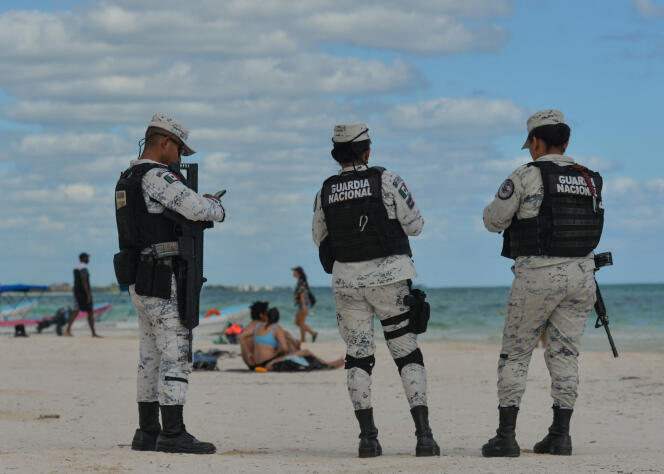
With their machine guns and bulletproof vests conspicuous on the sandy beach in Playa del Carmen, in southeastern Mexico, the police officers and national guardsmen pick their way between the towels, failing to disturb the thousands of vacationers basking in the sun. A few meters away, a Canadian couple was murdered at knifepoint on Tuesday, June 21, in one of the residences of this former fishing village, now a city of more than 330,000 inhabitants. And a month earlier, a mafia attack left three people injured in a trendy bar. These are just the latest bloody episodes in a series of violent outbreaks threatening this cornerstone of the Mexican economy that acts like a magnet for the drug cartels.
Here at the edge of the Caribbean Sea, in the heat of the night, the atmosphere is electrifying as thousands of young people stroll along the Quinta Avenida (Fifth Avenue), the city's main pedestrian artery. Playa del Carmen is the economic jewel in the crown of the state of Quintana Roo, lying between the famous seaside resorts of Cancun, to the north, and Tulum, to the south. Spanning a length of 130 kilometers, the tourist area welcomed 13 million vacationers in 2021. With 120,000 hotel rooms, the region concentrates almost half of the revenue from a sector representing more than 7% of the gross domestic product of Mexico.
On the terrace of the Cerveceria Chapultepec brewery, dozens of revelers are sipping craft beer. Little did they know that on Sunday, May 22, gunmen had opened fire there, wounding three Mexicans, including a seven-year-old girl who received a scratch on the head. The pressures of doing business prevailed, and the brewery quickly reopened. Had it been an outburst of gratuitous violence, or maybe a settling of scores? "Here, we prefer not to say too much to journalists," confided the manager of a nearby bar, who said that, this time, "there were only light injuries." Others have not been so lucky. On May 6, 55 kilometers from there, gunfire in a bar in Cancun left one dead and six wounded.
In this city with a population of nearly one million and which hosts an international airport, tourists discovered human remains on a beach in mid-March. Two days earlier, in Playa del Carmen, a British businessman was shot dead behind the wheel of his car by two assailants on a motorcycle. The code of silence also reigns among the employees of Mamita's Beach Club, located 400 meters from the Quinta Avenida. In January, its Argentinian manager was shot while in the bathroom of the sleek establishment. Today, its posh customers are seated under large white umbrellas, enjoying colorful cocktails as if nothing had happened.
You have 74.46% of this article left to read. The rest is for subscribers only.
Lecture du Monde en cours sur un autre appareil.
Vous pouvez lire Le Monde sur un seul appareil à la fois
Ce message s’affichera sur l’autre appareil.
Parce qu’une autre personne (ou vous) est en train de lire Le Monde avec ce compte sur un autre appareil.
Vous ne pouvez lire Le Monde que sur un seul appareil à la fois (ordinateur, téléphone ou tablette).
Comment ne plus voir ce message ?
En cliquant sur « Continuer à lire ici » et en vous assurant que vous êtes la seule personne à consulter Le Monde avec ce compte.
Que se passera-t-il si vous continuez à lire ici ?
Ce message s’affichera sur l’autre appareil. Ce dernier restera connecté avec ce compte.
Y a-t-il d’autres limites ?
Non. Vous pouvez vous connecter avec votre compte sur autant d’appareils que vous le souhaitez, mais en les utilisant à des moments différents.
Vous ignorez qui est l’autre personne ?
Nous vous conseillons de modifier votre mot de passe .
Lecture restreinte
Votre abonnement n’autorise pas la lecture de cet article
Pour plus d’informations, merci de contacter notre service commercial.
- Today's news
- Reviews and deals
- Climate change
- 2024 election
- Fall allergies
- Health news
- Mental health
- Sexual health
- Family health
- So mini ways
- Unapologetically
- Buying guides
Entertainment
- How to Watch
- My watchlist
- Stock market
- Biden economy
- Personal finance
- Stocks: most active
- Stocks: gainers
- Stocks: losers
- Trending tickers
- World indices
- US Treasury bonds
- Top mutual funds
- Highest open interest
- Highest implied volatility
- Currency converter
- Basic materials
- Communication services
- Consumer cyclical
- Consumer defensive
- Financial services
- Industrials
- Real estate
- Mutual funds
- Credit cards
- Balance transfer cards
- Cash back cards
- Rewards cards
- Travel cards
- Online checking
- High-yield savings
- Money market
- Home equity loan
- Personal loans
- Student loans
- Options pit
- Fantasy football
- Pro Pick 'Em
- College Pick 'Em
- Fantasy baseball
- Fantasy hockey
- Fantasy basketball
- Download the app
- Daily fantasy
- Scores and schedules
- GameChannel
- World Baseball Classic
- Premier League
- CONCACAF League
- Champions League
- Motorsports
- Horse racing
- Newsletters
New on Yahoo
- Privacy Dashboard
With drug cartel violence, is it safe to travel to Mexico? Security experts weigh in
MEXICO CITY – After years of hunkering down because of COVID-19, U.S. travelers are heading out, and Mexico is again one of their favorite destinations.
More than 21 million international tourists traveled to Mexico between January and July this year. Of those, nearly 8 million were from the U.S., government data shows .
That’s a 41% increase in the number of U.S. visitors, when compared to the same time period in 2021.
Mexico’s rich culture, beaches, resorts, Mayan and Aztec ruins and distinctive cuisine combine to make it one of the top 10 most visited countries in the world.
But there’s also a darker side to that allure.
Mexico is constantly making headlines about security, as drug cartel-fueled violence spreads from the white sands of Tulum to the Pacific coast.
"My friends used to call me and ask, 'I want to send my daughter down to Cancun for spring break.' I'd show them the phone with all the violence down there and say, 'I wouldn't be sending my daughter there because that's too risky,'" former U.S. DEA Special Agent Derek Maltz said.
Knowing the level of that risk in advance is crucial, experts say.
Like in any country, there are some dangerous places and others that can be visited without trouble. Common sense is the key when traveling to potentially hostile areas, experts say.
Everard Meade, director of Proceso Pacifico, a peace-building organization based in Mexico, said “foreign tourists are really safe.”
“I mean, there's just so few incidents where foreign tourists are victims of violence and particularly homicide. Organized crime groups know that it's not productive to target them. They know that if they did that, the result would be the National Guard running all over the city. And they just don't want that.”
For those considering a trip to Mexico, here’s a list of some of the most visited destinations by U.S. tourists and what the experts are saying about each:
Cancun and the Riviera Maya
Cancún’s airport is Mexico’s most popular landing destination for foreign visitors, including more than 3.4 million U.S. citizens between January and July of this year.
Its white-sand beaches with turquoise water, shopping malls, Mayan ruins and luxury resorts make it a top destination.
Cancun is located on the stretch of Caribbean coastline on Mexico’s northeastern Yucatán Peninsula. South of the city, along the coast, is known as the Riviera Maya, an area that includes Tulum, another destination hotspot.
In the past year, an increasing threat of violence has plagued the area, however.
The U.S. State Department issued a warning on Aug. 17 to Americans planning to travel there.
Tourists were warned to “remain in well-lit pedestrian streets and tourist zones” in the wake of shootings between rival drug cartels that have injured bystanders.
Last fall, two tourists were killed while having dinner in an outdoor restaurant in Tulum. A month later, guests at a resort in Puerto Morelos were forced to hide after gunmen arrived by boat and killed people.
And in January, two Canadian tourists were killed at a luxury hotel in Playa del Carmen the same month the manager of a popular beach club was murdered in a restroom by two men who fled on a jet ski.
“When you see things like that happening, that's just an indication that the cartels are fighting each other to gain control of those areas, not just for drug smuggling routes, but also for the street sale of drugs,” said former U.S. Marshal for the Western District of Texas Robert Almonte.
More: US tourists beware: Popular Mexico getaway plagued by drug cartel intimidation and violence
Courier Journal reporters traveled to Tulum in July and witnessed the presence of drug cartels, a situation that prompted an exit from the area the next morning.
“(Tourists) go to the beach resorts, and some of them are drug users. So, they're buying drugs, and you have the cartels fighting each other over those sales,” Almonte said.
Even though some tourists have been killed in the Riviera Maya, security analysts agree they aren’t the target of criminal groups.
“Sometimes, it's just being in the wrong place at the wrong time,” said Scott Stewart, vice president of TorchStone Global, a U.S.-based security firm.
“But, certainly, I have a lot of clients that have businesses operating in Mexico. And you can do so if you're careful and if you know the risks ahead of time and if you have plans to mitigate the risks ― you can certainly have a great visit there,” Stewart told The Courier Journal.
Mexico City
With its 22 million residents, Mexico City is one of the most populated metropolises in the world.
Its history makes it a unique destination. It has the largest park in Latin America, “Chapultepec Forest,” more than 150 museums and a multitude of restaurants and bars that make up its iconic nightlife.
“I would tell people that Mexico City, in general, is safer than the beach resorts,” said Almonte, who is now a Texas-based security consultant.
But a city with such a population also has its risks. In Mexico City, local gangs working for powerful cartels control the illegal drug trade, using extortion and kidnappings to maintain their grip.
Then again, the presence of law enforcement is bigger than in other states.
More: Outbreak of Mexican cartel violence targeting innocents raises worries of what’s to come
The U.S. State Department’s website tells travelers to: “Exercise increased caution when traveling to Mexico City due to crime.”
“Both violent and non-violent crime occurs throughout Mexico City. Use additional caution, particularly at night, outside of the frequented tourist areas where police and security patrol more routinely. Petty crime occurs frequently in both tourist and non-tourist areas,” the advisory reads.
“You do have more law enforcement security there in Mexico City. So, I would say if I had a choice, I would go to Mexico City rather than Cancun or Puerto Vallarta, ” Almonte advised.
"The border is attractive because if you live anywhere near … for example, in California, you can go down from Los Angeles the same day and visit Tijuana,” Meade, the director of Proceso Pacifico, said.
The northern city of Tijuana borders Chula Vista in the U.S. Nearly 100,000 people cross the border every day to work, for fun, for medical purposes, etc.
Border cities have a unique flow and routine. Tijuana has become a destination for Californians.
“It's attractive because I think the culinary scene and the art scene in Tijuana, they're really vibrant. It's a lot more experimental and less risk averse than food and arts in the U.S., ” Meade said.
However, as tourism has increased, so has crime.
“ There's a serious problem with violence in Tijuana, and it's a problem that a lot of the boosters of the region have tried to kind of hide for a long time. And it's not hidable anymore,” Meade said.
In August, cartel members launched a campaign of terror on the streets of Tijuana, setting vehicles on fire and roadblocks. The U.S. Embassy there urged U.S. government employees to shelter in place.
More: 'Fascinated by death': Why Americans can't get enough of vicious drug cartel drama
The State Department advises on its website: “Reconsider travel to Baja California due to crime and kidnapping.”
“I think what happened, it wasn't new. It didn't represent a new level of violence. It represented a new spectacle. But that violence is there, and it's been there. Tijuana has been one of the most violent municipalities in the world very consistently since 2017,” Meade said.
Tourists, though, have often been able to stay above the fray in Tijuana, security analysts agreed.
“ … Violence doesn't target tourists and foreign visitors, it really just doesn't, and that's the paradox of it,” Meade said.
Many Americans have moved to Tijuana or invested there in the last decade.
“ We've got tens of thousands of people in San Diego whose health insurance has all the services provided in Tijuana. It's a multibillion-dollar industry there, and bad things are not happening to them. They're fine.”
On the other hand, trouble can arise, such as during spring break, if visitors seek it out, he said.
“ I think buying and doing drugs in Tijuana, really anywhere in Mexico, is colossally stupid,” Meade said.
“It's just a very bad idea because it makes you incredibly vulnerable to either organized crime or to corruption frankly, by law enforcement, if they catch you with marijuana, with cocaine or something, they've got you, and they've got leverage over you.”
Puerto Vallarta
As of July, more than 800,000 Americans have visited Puerto Vallarta this year, government data shows. Located on Mexico’s Pacific Coast, Puerto Vallarta is home to stunning beaches, sports, nature and nightlife.
But it’s also the home of a very powerful drug cartel.
The U.S. Department of Justice considers the Jalisco New Generation Cartel (CJGN) to be one of the five most dangerous transnational criminal organizations in the world.
What does this mean for travelers?
“The concern is that the tourists are going to be sitting at a table, where the intended target is. These cartels go in there, and when they're going to kill their target, they're not very careful,” Almonte said.
“Unfortunately, innocent people are struck, and they're injured or killed.”
More: A ruthless Mexican drug lord’s empire is devastating families with its grip on small-town USA
U.S. law enforcement officials recommend staying away from Puerto Vallarta. The State Department says to “reconsider travel” to the state of Jalisco because of crime and kidnappings.
“If you were thinking rationally about this, what you want to do is you want to avoid being of any interest to organized crime,” Meade said.
“In other words, things that most tourists just don't need to worry about if you're in the right place, and the right place is the main tourist quarter. So, if you're on the Malecon, you're around the beach, you're fine,” Meade told The Courier Journal.
Only six states in Mexico have the warning “do not travel” from the U.S. State Department, and one of those is Guerrero, where Acapulco is located.
Once a tourist paradise for international travelers, Acapulco has become a city with incredibly high homicide rates.
Still, though, it remains a destination for domestic travelers and a weekend getaway for the rich and famous. Beaches, food and nightlife are the main attractions.
“Acapulco is the one place where I would really tell people to hesitate. And I hate doing it,” Meade said.
He said the state of Guerrero has a combination of high levels of violence and political corruption, “but also extreme poverty that makes violence more complex.”
Analysts say the dynamics of Acapulco tourism have changed. Even though there are still foreign tourists visiting, it has nosedived in the past years.
“The general guidance on Acapulco is that if you stay in the Zona Dorada (the main tourist area or Golden Zone), you're OK. I think Americans often don't understand the huge wealth gap between southern and northern Mexico. And when you combine that with the violence, it really does change the quality of safety and security,” Meade explained.
Almonte recommends travelers hire transportation prior to their arrival in Mexico.
“Based on my experience and my research, I would recommend that the first thing is to make sure you have some transportation that is more reliable and trustworthy, and I would recommend doing that through the hotel.”
More: 'It can happen to you': How 1 laced pill cost a Louisville mother her son forever
Almonte agreed that tourists visiting Mexican resorts should stay in that area.
“I would not venture off into other areas of the neighborhood, things of that nature, because tourists are going to stand out to the cartels and the gangs as tourists.”
Also known as “The Pearl of The Pacific Ocean,” this resort town is in northern Mexico, along the Pacific shoreline in the Sinaloa state.
Its fine residences, historic center, deep blue seas, aquatic sports and unforgettable sunsets in the Golden Zone have attracted tourists from all over the world. It also has a community of working and retired ex-pats, Americans among them.
Sinaloa is also home to the violent Sinaloa Cartel and is another of Mexico’s six “do-not-travel” states, according to U.S. State Department advisories, which cite crime and kidnapping as the reasons. However, U.S. government employees may travel to Mazatlán by air or sea only and “are limited to the Zona Dorada and historic town center, and must travel via direct routes between these destinations and the airport and sea terminal,” the advisory reads.
Regarding traveling to Mazatlán, “What you need to do is just do your research, understand the threat environment, understand your own risk threshold and what you're willing to take,” said TorchStone Global’s Stewart.
“… If I were a tourist, and I'm visiting, and I didn't have somebody guiding me, traveling on the highways between cities at night ― I would not do, ” Meade said of Sinaloa.
Karol Suárez is a Venezuela-born journalist based out of Mexico City. She is a contributing writer to The Courier Journal. Follow her on Twitter at @KarolSuarez_.
This article originally appeared on Louisville Courier Journal: Mexico tourist locations: Safety of popular Mexican destinations
Recommended Stories
2024 nfl draft grades: denver broncos earn one of our lowest grades mostly due to one pick.
Yahoo Sports' Charles McDonald breaks down the Broncos' 2024 draft.
NFL Draft: Packers fan upset with team's 1st pick, and Lions fans hilariously rubbed it in
Not everyone was thrilled with their team's draft on Thursday night.
NFL Draft: Bears take Iowa punter, who immediately receives funny text from Caleb Williams
There haven't been many punters drafted in the fourth round or higher like Tory Taylor just was. Chicago's No. 1 overall pick welcomed him in unique fashion.
NFL to allow players to wear protective Guardian Caps in games beginning with 2024 season
The NFL will allow players to wear protective Guardian Caps during games beginning with the 2024 season. The caps were previously mandated for practices.
NFL Draft: Spencer Rattler's long wait ends, as Saints draft him in the 5th round
Spencer Rattler once looked like a good bet to be a first-round pick.
Cowboys owner Jerry Jones compared his 2024 NFL Draft strategy to robbing a bank
Dallas Cowboys owner Jerry Jones made an amusing analogy when asked why the team selected three offensive lineman in the 2024 NFL Draft.
Korey Cunningham, former NFL lineman, found dead in New Jersey home at age 28
Cunningham played 31 games in the NFL with the Cardinals, Patriots and Giants.
2024 NFL Draft grades: Kansas City Chiefs get even richer with one of the best hauls this year
Yahoo Sports' Charles McDonald breaks down the Chiefs' 2024 draft.
Michael Penix Jr. said Kirk Cousins called him after Falcons' surprising draft selection
Atlanta Falcons first-round draft pick Michael Penix Jr. said quarterback Kirk Cousins called him after he was picked No. 8 overall in one of the 2024 NFL Draft's more puzzling selections.
Panthers owner David Tepper stopped by Charlotte bar that criticized his draft strategy
“Please Let The Coach & GM Pick This Year" read a sign out front.
2024 NFL Draft grades: Baltimore Ravens do what they do best — let good players fall into their laps
Yahoo Sports' Charles McDonald breaks down the Ravens' 2024 draft.
NBA playoffs: Tyrese Hailburton game-winner and potential Damian Lillard Achilles injury leaves Bucks in nightmare
Tyrese Haliburton hit a floater with 1.1 seconds left in overtime to give the Indiana Pacers a 121–118 win over the Milwaukee Bucks. The Pacers lead their first-round playoff series two games to one.
Legendary basketball star Candace Parker announces her retirement
Candace Parker announces her retirement from women's basketball after 16 seasons in the WNBA and a stellar college career at Tennessee.
2024 NFL Draft grades: Minnesota Vikings risked a lot to get J.J. McCarthy and Dallas Turner
Yahoo Sports' Charles McDonald breaks down the Vikings' 2024 draft.
New Bills WR Keon Coleman makes hilarious first impression with Macy's shopping advice and more
If nothing else, the Bills have a player who can recognize a good deal.
UPS and FedEx find it harder to replace gas guzzlers than expected
Shipping companies like UPS and FedEx are facing uncertainty in U.S. supplies of big, boxy electric step vans they need to replace their gas guzzlers.
Dave McCarty, player on 2004 Red Sox championship team, dies 1 week after team's reunion
The Red Sox were already mourning the loss of Tim Wakefield from that 2004 team.
These are the fastest-selling new cars of 2024
iSeeCars found that a handful of brands sell new cars much faster than others and noted that EVs are taking longer to sell than hybrids.
2024 NFL Draft grades: Green Bay Packers' stockpile of picks put to good use
Yahoo Sports' Charles McDonald breaks down the Packers' 2024 draft.
Texans WR Tank Dell sustains 'minor injury' in mass shooting, was reportedly 1 of 10 shot at Florida nightclub
Tank Dell is in "good spirits" after being reportedly being "caught in the crossfire" of the shooting that left 10 injured at a Florida nightclub.
- International edition
- Australia edition
- Europe edition
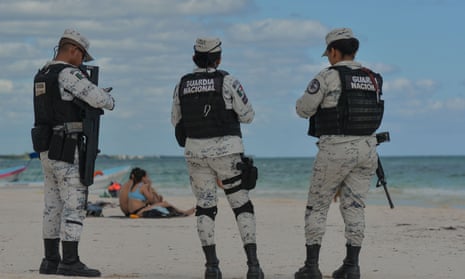
Tourists bask on a battlefield as drug gangs fight over Mexican resort town
Tulum, jewel of the Mayan Riviera, risks emulating Acapulco, another once glamorous resort now overwhelmed by violence
Bright yellow police tape fluttered in the breeze outside a restaurant just off the main strip in the Mexican resort town of Tulum, as the lights of a nearby police truck flashed blue and red.
Troops in camouflage fatigues stood guard outside the deserted late-night eatery La Malquerida, “The Unloved” – the site of a gangland shooting that killed two female tourists and wounded another three holidaymakers.
Anjali Ryot, an Indian travel blogger who lived in California and was on holiday celebrating her birthday, and German tourist Jennifer Henzold, died in the 20 October attack that is believed to have been launched by one of several local crime groups in an attempt to assert control over the area’s drug and extortion rackets.
The attack made headlines around the world. But within days, the scene on Centaura Sur Street was back to normal: on a recent evening, restaurants were packed and the aromatic smell of the copal incense burned by street traders filled the air.
Most tourists flocking to the Mayan Riviera are unaware that they are holidaying on a battlefield, said one local worker. “They’re chilling, but they’re in the middle of a war,” he said.
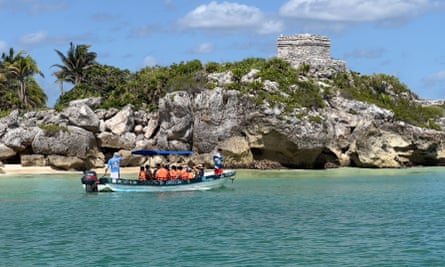
The violence is not restricted to Tulum. Last month, guests at a resort 100km up the coast near Cancún rushed for cover after masked gunmen stormed a hotel beach by boat and opened fire, killing two suspected rivals.
The two attacks are just the latest in a string of high-profile incidents along the Mayan Riviera that have put the crown jewel of the country’s tourism industry on edge.
Tourists still flock to Tulum, drawn by its yoga retreats and Instagram-friendly white sand beaches and ancient Mayan ruins. The town, which in 2017 declared itself the world yoga capital, is also a fixture on the global DJ circuit.
But the violence has prompted fears that it may follow the path Acapulco – a once-glamorous resort town now overwhelmed by drug violence.
“Tulum is swiftly becoming very dangerous and could become another Mexican monster town,” warns Dr Rafael Barajas, president of Tulum’s citizen observatory. “Everyone is extremely upset about the violence. We’re looking at this, frightened, and wondering if it’s going to end.”

Between January and September, Tulum saw 65 murders – an 80% rise on the same period last year . Visitors from Spain, Belize and Uruguay have been among those killed. On a recent afternoon, two gunshots rang out downtown but few people batted an eyelid – and a group of traditional musicians started performing nearby almost immediately.
Meanwhile in Cancún, two Mexicans were killed and an American woman was wounded in June when gunmen opened fire from jet skis. The following month, a US firefighter was found dead in a resort hotel; local authorities maintain the holiday-maker was asphyxiated while crawling though a window but his family believe he was kidnapped and killed.
Tourists appear mostly oblivious to the rising strife, as they often do not stay for long, but locals describe an atmosphere of fear and mistrust.
In April, President Andrés Manuel López Obrador, known as Amlo, described the local police as “rotten” and they were replaced by state officers after a string of abuses including the death in custody of a Salvadoran refugee.
Mexico’s government has announced plans to deploy a battalion of national guards to the region, and build a base in Tulum.
But Amlo’s anti-crime strategy has failed to stop the bloodshed, and murder rates remain stubbornly high. The president has been criticized for his reliance on the military rather than reforming the police, who are often outgunned by warring crime factions.
Local officials say that about 10 rival groups are fighting to control Tulum’s extortion rackets and the lucrative local drugs market. “We are facing an issue of supply and demand for drugs,” prosecutor Oscar Montes de Oca told local radio.
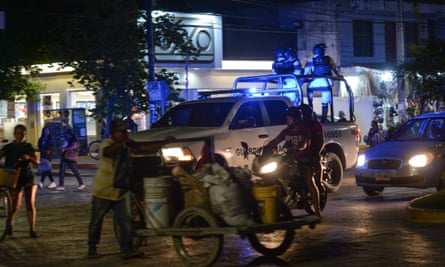
Hoteliers have blamed growing demand for narcotics on a boom in festivals and parties, which continued throughout the pandemic.
One bar worker said establishments face a choice of paying protection money, permitting drug sales on their premises, or shutting down
The rapid growth of Tulum’s tourist industry has brought not just violence but starkly uneven development and serious environmental damage.
“If we stay on this path there are going to be more and more shootings and people will continue to sell their places and leave,” said Karla Acevedo, spokesperson for a group of environmental activists, Sustainable Tulum. “Tulum has to decide what kind of destination it wants to be.”
“Birds and mammals have been killed on the highways after fleeing big events in the jungle and loud music,” she adds. “Plus, we’re connected to the biggest underground freshwater system in the world and we’re polluting it because we don’t have proper sewers.”
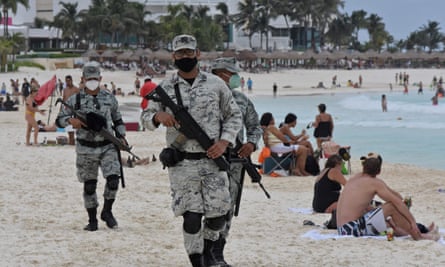
A new airport is expected to boost a tourism industry that brings in the majority of the state’s revenue. A record number of Americans reportedly visited the Quintana Roo region in 2020, with about 4 million tourists of all countries coming to Tulum each year.
To cater for the growing demand, the building of new condominiums and luxury hotels proceeds apace – casting a growing shadow over adjacent shanty towns.
“There’s a feeling you can do whatever you want to do when you come to a place like Tulum,” said Acevedo, of investors, tourists and criminals. “There is so much corruption and impunity; it’s generating a sense of chaos.”
- Drugs trade
Most viewed

American tourists 'wiped off face of earth' as Mexico drug cartels expand feud to hotspots
Popular resorts across Mexico are no longer "off limits" for brutal cartel killers, according to a private investigator.
Tropical hotspots between Cancun and Tulum have seen a spike in violent crime over the past few years, prompting the Mexican government to deploy police to busy beaches in a desperate bid to keep the peace.
PI Jay Armes III noted rocketing crime rates are the result of an ongoing feud between four Mexican drug cartels indiscriminately killing each other and innocent bystanders to assert their dominance.
Armes warned Americans and other foreign visitors have become collateral damage in the brutal conflict or witnesses to gruesome violence.
He said some tourists "just disappear, wiped off the face of the earth" if they are found to have seen too much.
READ MORE: The paradise for US tourists overrun by bloody gang crime and a sky-high homicide rate
Local broadcasters only this month have reported cartel members dismembered rivals from another group with machetes in Cancun.
A Californian woman living in Mexico was accidentally killed after getting caught in the crossfire of two disputing cartels while watching the sunset near a popular resort in Tulum.
A New York man was abducted and taken to the jungle , where he was tied up and had his eyes taped shut as cartels demanded a $200,000 ransom.
Armes told Fox News Digital : "It's all horrifying to us, but to people in Mexico, it's just a Tuesday. This happens all the time all over the country.
"But now it's happening in areas that used to be off limits."
The private investigator explained cartels used to abide by a "code similar to the Italian mob ," with clear borders between rival territories and strict rules on who could and could not be targeted.
DON'T MISS:
FBI warns MS-13 and brutal Venezuelan migrant gang could join forces in NYC [REPORT]
'Armed and dangerous' teen from identified in Times Square shooting [LATEST]
Woman feels 'blessed' after moving to Germany with 3 'wonderful' sister wives [INSIGHT]
Click here to follow Daily Express US on Google News to stay up to date with all the latest US, showbiz, and sports news.
He continued: "In the old days, you weren't allowed to target women or children. You weren't allowed to encroach on another cartel's territory.
"And the resorts were off limits. ... Cartels wanted to fly under the radar as much as they could."
Armes noted attacks on Americans or other tourists usually resulted in "mandatory, swift" action from the Mexican government and brought unwanted attention to the cartels.
With tourism the main legal source of income for Mexico, with an estimated 66 million people visiting in 2022 alone, violence around resort towns used to be a rarity up until 15 years ago.
But the private investigator claimed that "the rules have changed," and "that old guard code is out the window. The resorts are open shop."
"With all these young kids coming up (through the cartel ranks), there's no respect for anything ," Armes said, "It's become a free-for-all."
He suggested social media played a key role in the changes, suggesting promotional posts by influencers resulted in a tourism boom - leaving the door open to drug cartels looking for new customers.
He added: "Who we see as tourists are potential customers or potential victims to the cartels.
"Even if it's one percent or five percent (of tourists to the resort areas), that's millions of customers and a big chunk of business."
He identified the four main cartels seeking to establish dominance in the area as the Gulf Cartel, the Jalisco New Generation Cartel , the Grupo regional and El Chapo's former group, the Sinaloa Cartel .
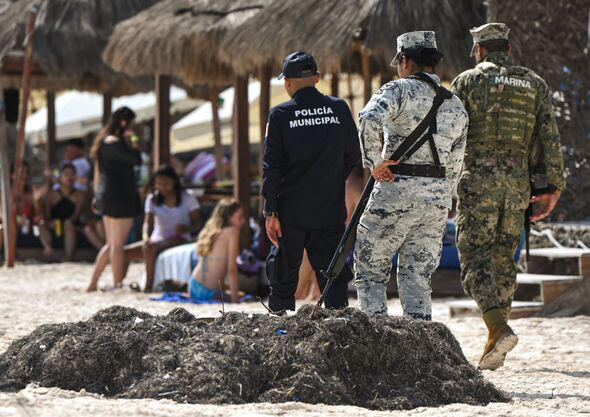
Michigan Journal of Economics

Drugs, Violence and Crime in Mexico: Their Drastic Impact on the Tourism Industry and the Economy
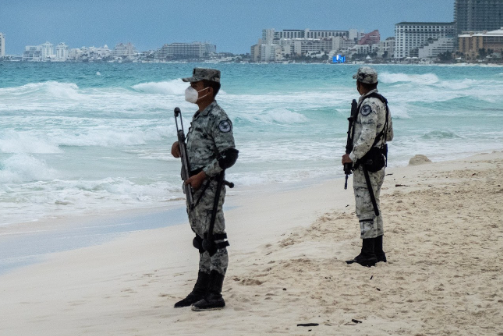
Written by Ashley Slud
A trip to Mexico with delicious food, drinks and relaxing beaches – what could go wrong? Well unfortunately, a lot. Within the past 20 years, there has been a large increase in the number of homicides and drug-violence related crime in Mexico. The two tourism spots that this paper will analyze are Cancún and Playa del Carmen, as these are two of the most popular destinations for travelers (López, Statista).
As of April 2022, Cancún has a moderate level of crime at 59.80, and a high rate of crime increasing within the past 3 years (74.32). In just 2021 and 2022, there were 337 murders in Cancún with a homicide rate of 36.81 per 100,000. The global average is around 6 per 100,000. (Cuse, Cancun Sun). The vacation spot has unfortunately moved up to number thirty-six in the top fifty most dangerous cities in the world, from number forty last year. Just recently, in the beginning of 2022 in January, several gunmen killed the manager of a beachside club in Playa del Carmen during the day (Córdoba and Luhnow, Wallstreet Journal). In early February, there were reports of a man being killed on a path near Laguna Manati, a natural area on the outskirts of Cancún. This occurred at the same time as “at least 15 gunshots from an AK-47 were fired at a house in that state and a reporter was nearly gunned down in the town of Isla Mujeres” (Cruz, Agencia Efe). Additionally, in mid-March 2022, tourists on a beach in the hotel zone in Cancún found a spinal cord, a femur and a part of a pelvis. After examination, police forces believe the remains may be linked to an organized crime (Córdoba and Luhnow, Wallstreet Journal).
Quintana Roo, the Mexican State where Cancún is located, is also home to Playa del Carmen, the islands of Cozumel and Isla Mujeres, and other towns. In Quintana Roo, the tourism industry is the main source of revenue in their economies. In fact, tourism accounts for 87% of their GDP (Valenzuela & Tendian, StoryMaps). Drug distribution is a major issue in Quintana Roo as well. Drug cartels cater items such as Mexican-grown cannabis, Colombian pot, or other local drugs to tourists, as it is much easier and cheaper for the cartels, eliminating the risks of crossing the border. Tourists are also more likely to try these drugs, as they are not able to have access to them in their respective homes. Drugs are also sold openly in club bathrooms, and cartels often place dealers inside of restaurants. The club and restaurant owners don’t go to the authorities because they are scared of the gang’s response (Malkin, NY Times). The popularity of drugs has contributed to the increase in the number of homicides in Mexico. Homeless people or other locals on the street may try to sell drugs to tourists, and if the tourists aren’t interested, they may be scared off and deterred from ever going to the destination again.
Government officials are trying to get ahead of the problem so that the state does not become like Acapulco, a beach resort town on Mexico’s Pacific Coast which had previously been the murder capital of the world due to cartel feud. For instance, state and federal officials have “increased the number of state police to 1,500 officers. [They have added] around 2,500 new security cameras along the coast, some with facial recognition technology, [which] have helped authorities make arrests” (Córdoba and Luhnow, Wallstreet Journal). Informal police tents are also being set up every few kilometers with Mexico National Guard members and police, in order to bolster security and decrease crime along these areas.
So what do these incidences of homicide, and other dangerous events mean for the industry that truly supports the livelihood of the countries? The 2018 Mexico Peace Index (MPI) shows that the economic impact of crime and violence to the Mexican government amounted to 4.72 trillion pesos (US $249 billion) in 2017, which is 21% of the country’s GDP. Homicide made up 46% of this impact. The tourism industry consists of many micro enterprises, which includes many family-owned businesses that employ fewer than ten people. These companies could be restaurants, art shops, gift-shops, etc. With the spike in crime, these micro businesses have to cancel growth plans, must reduce working schedules, and cancel distribution routes. Decreases in desire to travel to Mexico can severely harm these families’ income that rely almost entirely on tourists (Saborowski, World Economic Forum). In order for Mexico to improve both the safety of their residents and tourists, and the stability of their economy, they must continue allocating resources and time into protection and security against these crimes. It is critical for Mexico’s crime rates to decrease, as their economy relies so heavily on tourism that locals truly cannot survive a major loss in visitors.
“Crime Wave in Mexico’s Caribbean Region Prompting Tourism Concerns.” Www.efe.com, 4 Feb. 2022, https://www.efe.com/efe/english/world/crime-wave-in-mexico-s-caribbean-region-prompting-tourism-concerns/50000262-4732582. Cruse, Author Steven. “Cancun Joins 7 U.S. Cities on Top 50 Most Dangerous in the World.” Cancun Sun, 10 Mar. 2022, https://thecancunsun.com/cancun-joins-7-u-s-cities-on-top-50-most-dangerous-in-the-world/#:~:text=Cancun%20saw%20337%20murders%20in,the%20presence%20of%20organized%20crime. José de Córdoba, David Luhnow. “Cancún’s Tourist Idyll Is Shattered by Drug Violence and Homicides.” The Wall Street Journal, Dow Jones & Company, 3 Apr. 2022, https://www.wsj.com/articles/cancun-tulum-riviera-maya-mexico-drugs-homicides-11648853578 López, Ana M. “Top Tourist Destinations in Mexico.” Statista, 21 Sept. 2021, https://www.statista.com/statistics/1135858/leading-tourist-destinations-mexico/#:~:text=Mexico%20City%20was%20the%20leading,visitor%20arrivals%20that%20same%20year Malkin, Elisabeth. “Along Mexico’s Riviera Maya, Tourists, Drugs and Violence.” The New York Times, The New York Times, 25 Feb. 2022, https://www.nytimes.com/2022/02/25/travel/cancun-tulum-mexico-shooting.html. Martina Valenzuela, Nadia Tendian &. “A Recipe for Disaster: Planned Tourism Development in México.” ArcGIS StoryMaps, Esri, 19 May 2021, https://storymaps.arcgis.com/stories/6b1666acb1634586bfe55a622b738fd8. Saborowski, Christian. “Here’s How Much Mexico’s Spike in Crime Hurts the Economy.” World Economic Forum, https://www.weforum.org/agenda/2018/12/chart-of-the-week-mexico-s-spike-in-crime-hurts-the-economy.
- Share full article
Advertisement
Supported by
Along Mexico’s Riviera Maya, Tourists, Drugs and Violence
On the stretch of beaches from Cancún to Tulum, there have been a number of gang-related incidents in which international visitors have been killed or injured. But that hasn’t stopped the vacationers from coming.

By Elisabeth Malkin
The headlines out of Mexico have been jarring. Two women were killed in the crossfire when rival gangs started shooting at a popular sidewalk restaurant in Tulum. Gunmen battled on a beach near Puerto Morelos as tourists scrambled into a Hyatt hotel for cover. A killer-for-hire bought a day pass to an all-inclusive resort in Playa del Carmen to carry out a hit in a poolside snack bar.
But the spate of violent incidents along the country’s Riviera Maya, the strand of Caribbean beaches stretching 80 miles south of Cancún to the Mayan ruins of Tulum , over the past few months hasn’t seemed to scare off the vacationers who arrived by the millions last year to spend a pandemic holiday on the beach, dive the coral reefs or dance in boho bars.
“It’s all like drug-related violence so it doesn’t affect us,” said Elizabeth Sedgemore, 50, of Seattle, who was walking in Puerto Morelos one recent noon looking for a restaurant with her husband, Gregory, 59. He added: “We just don’t put ourselves in situations where we’re going to be in trouble. We don’t do drugs, we don’t deal drugs, we don’t stay out late — so we feel very safe.”
The region, part of the state of Quintana Roo, quickly reopened after the first few months of the pandemic, as Mexico welcomed foreign tourists while much of the world stayed closed. The country imposed not a single restriction on entry by air — travelers, vaccinated or unvaccinated, could come in without testing for the coronavirus and faced no quarantines. Within Mexico, shutdowns varied according to state and even within Quintana Roo as the pandemic progressed, with limits on occupancy in hotels and restaurants and widespread use of masks indoors.
Tourists often seemed to take the rules more lightly than most Mexicans, who were hit hard by the pandemic. Mexico has confirmed more than 315,000 deaths from Covid-19 but experts believe the toll is much higher. Government figures show that during the pandemic, excess mortality, or the number of deaths above what would have expected under “normal” conditions, has climbed above 667,000.
But as other resort areas enforced restrictions, Tulum, which markets its hippy chic spirituality , continued to party , and in November 2020, it hosted a five-day festival that became a coronavirus superspreader event.
Now that tourists have returned in full force to all of the Riviera Maya, its long-festering problems are coming into focus. Alongside the glitz of the region’s all-inclusive resorts, authorities and business groups say, are boomtowns where entrenched criminal gangs operate openly to sell drugs and extort local businesses.
“Unfortunately people come to consume drugs and alcohol,” said Óscar Montes de Oca, the prosecutor for the state of Quintana Roo. “They come to do things they wouldn’t do at home. This demand creates a supply and that generates all the conflict.”
The warning signs have been flashing for several years, particularly in the region’s largest town, Playa del Carmen, where an attack on an international music festival in 2017 killed five people. In 2019, gunmen opened fire in a local working-class bar , killing seven men.
What is new is how openly the gangs have taken their battles to the heart of tourist zones.
The recent spate began in Tulum on Oct. 20, when the leader of a gang darted into La Malquerida restaurant to escape an attack from rivals, who instead accidentally killed a woman from Germany and an Indian-born woman who lived in California. Three other European tourists were injured.
Some two weeks later, on Nov. 4, two gangs engaged in a shootout on a beach near Puerto Morelos called Bahía Petempich, as tourists at the Hyatt Ziva Riviera Cancún hotel fled into the lobby, where crouching staff ushered them up the stairs into safe rooms. Two of the gunmen were killed and a tourist from Utah was injured.
“What makes it shocking is that you feel safe at these all-inclusive resorts,” said Mike Sington, a retired entertainment executive from Los Angeles who was staying at the Hyatt and posted video of the hotel guests in hiding. “They’re all walled off and secured off,” he said.
At the Hotel Xcaret in Playa del Carmen on Jan. 21, a gunman managed to gain entry to the hotel grounds where, authorities say, he shot and killed two Canadian men and injured the wife of one of them. The murder victims had ties to organized crime in Canada , Mr. Montes de Oca said, adding that they were killed over a debt related to arms and drug trafficking. A man accused of scouting the complex for several days before the hit and driving the getaway car, as well as a Canadian woman who was seen speaking to the hit man before the shooting, are both under arrest.
Those killings were followed by the murder of the Argentine manager of a beach club in Playa del Carmen on Jan. 25. Authorities say that he was killed by members of a gang that had planned a giant party at the club. When municipal authorities blocked the event, the gang took revenge on the club.
And the violence has continued. On Feb. 19, rival drug dealers opened fire at Art Beach Tulum , a restaurant on the outskirts of Tulum where an order of sea bass with asparagus risotto and seaweed cream goes for $35. Two of the dealers were killed.
That event highlighted how Tulum in particular has become a center for drug consumption in the Riviera Maya. Ten gangs have carved up sales in the area, Mr. Montes de Oca said, and when they encroach on each other’s territory, what “begins as a minor crime, selling drugs, ends in tragedy.”

52 Places for a Changed World
The 2022 list highlights places around the globe where travelers can be part of the solution.
Reaction to a clampdown
Local authorities say that the latest round of violence is a reaction to the state’s efforts to clamp down on crime, after law enforcement was ignored under previous state governments. Police have moved cartels off the beaches and main streets where dealers sell souvenirs or offer massages as cover. Investigations of gangs that sell drugs in restaurants and bars have led to the arrest of hundreds of gang leaders, said Lucio Hernández Gutiérrez, the secretary of public security for Quintana Roo.
The groups “want to continue their hold on these spaces that give them exorbitant profits,” he said.
With investment in police training and technology, statewide rates for homicide and most violent crimes have fallen over the past three years, Mr. Montes de Oca said, but he acknowledged that the recent violence had created a problem for the state. “These events occur in iconic places that are very vulnerable in terms of media and this affects the perception of safety in the state a lot,” he said.
More than 6.6 million foreign tourists flew to Cancún and the Riviera Maya last year, according to the Mexican tourism ministry, with more arriving on cruise ships or domestic Mexican flights, and all of them except a handful enjoyed a peaceful holiday. It is Mexicans who overwhelmingly suffer the weight of the violence and it crosses all classes, as it has across much of the country. Construction workers on a luxury hotel site were extorted and co-opted by drug cartels. A candidate for mayor of Puerto Morelos was shot and killed in a restaurant. Taxi drivers in Tulum are killed in their cars and restaurant owners say that extortionists leave them handwritten messages accompanied by a warning bullet.
Since the outbreak of violence in tourist areas, Quintana Roo law enforcement officials have moved quickly to announce arrests in each case. In December, an additional contingent of about 1,500 members of Mexico’s National Guard began patrolling the beaches in a sign of how seriously the federal government has taken the threat to Mexico’s tourist industry.
But many question how sustainable that approach is. “For me, it’s just a facade,” said Fabiola Cortés, a lawyer and journalist who helped expose the dealings of Quintana Roo’s previous governor . He is now in jail, facing trial on corruption charges. “When high-impact events take place, they just detain anybody.”
David Ortiz Mena, the president of Tulum’s hotel association, said that Tulum’s rapid growth over the past few years had been uncontrolled, with no thought given to the effect of throwing jungle parties for 5,000 people. He acknowledged that the authorities had begun to make some progress, but added, “The fact that the police can’t grow along with the population is also a problem of sustainability.”
Growing tourist numbers
For now, it seems that most tourists who have heard of the killings seem willing to weigh the risks and make the trip to the Riviera Maya.
In December, when four out of five members of Pam Singh’s family had Covid-19, she decided that “we have to get something great out of this” and booked a holiday to take advantage of the family’s post-illness immunity.
Ms. Singh, 47, who lives in Brooklyn, had already traveled to Puerto Vallarta, on Mexico’s Pacific Coast, and was looking for a destination that was easy to reach. “The scenery is beautiful, the hospitality is warm and the food is delicious,” she said. “It’s hard to argue with everything that Mexico has to offer.”
Researching reviews online, she settled on a week at an all-inclusive resort in Puerto Morelos, which promised activities for her three children, age 8 to 15, and good food.
She also saw the news of violence. “I didn’t find it especially alarming,” she said by phone from her hotel, noting that the resort was in a self-contained area. “I understand that it was out of ordinary for the region.”
But Ms. Singh, an international human rights lawyer, and her husband, Jeff Locke, 49, a teacher, may have a higher risk threshold than tourists coming from a placid rural area, she said. “We live in New York City and it’s not that crime isn’t increasing. You learn to live with it and take precautions. A vacation isn’t different.”
That seems to be the attitude many tourists are taking. Almost none of the recent inquiries to Del Sol Travels , which plans destination weddings in the Riviera Maya, have dealt with security, said Matt Adcock, the company’s owner.
“Do these people have concerns? I think they do,” said Mr. Adcock, an Atlanta native who has lived in Playa del Carmen since 2007. He thinks people have gotten numb during the pandemic. “I believe that they are weighing the risk to the reward and making the decision.”
The company has booked six weddings this year through April and is handling inquiries for 2023.
Missy Skoog, a travel adviser for Travel Leaders in Minneapolis said the overwhelming concern she hears from vacationers thinking of going to the Riviera Maya is the risk of getting stuck in Mexico because they test positive for the coronavirus before their flight back to the United States.
Ms. Skoog said the recent events are isolated incidents. If she felt the region, which she visits three or four times a year, weren’t safe, she wouldn’t send people to the Riviera Maya, which is one of her top-selling regions this year. “We have gained violence here,” Ms. Skoog said, referring to Minneapolis. “They have gained violence there.”
Not all tourists are convinced. Atul Tiwary, 27, a trader in the financial services industry in New York who has traveled several times to the Riviera Maya in the past, was planning to return in March with three friends. “One person proposed the idea of reconsidering because of this thing popping up and everyone agreed.” The group switched its destination to Cabo San Lucas.
“I’d say I’m a pretty adventurous traveler in terms of far-flung cultures,” he said. “What concerns me is violent crime that is pretty visible as a tourist.”
At the time of the shooting at the Hyatt Ziva Riviera Cancún, Vacaya , an L.G.B.T.Q. travel agency, had a group of about 700 guests at the hotel, including Mr. Sington. It was the third annual trip that Vacaya had booked to the Riviera Maya. This coming year in November, it will go to Puerto Vallarta instead, but the company had decided to change before the shooting incident, for variety. “We have not abandoned Riviera Maya,” wrote Vacaya’s co-founder Patrick Gunn in an email. “But we’ll consider the overall climate and improvements made by local authorities before heading back.”
Fear of gangs
Some local restaurants see drug sales as “a necessary evil,” said a restaurant owner with knowledge of the problem, who asked not to be identified by name because of fear of violent reprisal. Cartels arrive and force the restaurant to place a dealer inside the restaurant or at the entrance, he said. Owners don’t go to the authorities because they fear that corruption in the police means their complaint will get back to the gangs.
“There is always an option,” said James Tobin, a Cancún real estate agent and anti-crime activist who now serves on the federal government’s National Public Safety Council. “The option is to report or close down.”
“If all citizens believe that the police are corrupt, then the only ones who gain are organized crime,” he added.
Other business leaders agree that the government has shown willingness to attack crime and point to the arrests made after each incident, as well as broader investigations to determine the leaders of the gangs who carried out the shootings. “It’s not an overnight job,” said Iván Ferrat Mancera, the president of the Business Coordinating Council of the Caribbean, the region’s main alliance of business groups and nonprofit organizations. “If you confront them, there will be deaths.”
None of that seemed to be a worry for Angelica and Vincent Shields of New York, who are in their 70s and have been coming to Puerto Morelos for 20 years. “We got our vaccine and we got on the plane,” Mr. Shields said.
“We come here for a month and we feel safe,” said Ms. Shields, who said she was reassured by the presence of the National Guard. “Back home in New York, I see them as well.”
“I would just like to say, Viva Mexico, the people are great and the food is fantastic.” Not to mention, she added, the margaritas.
Alejandro Castro contributed reporting from the Riviera Maya.
Follow New York Times Travel on Instagram , Twitter and Facebook . And sign up for our weekly Travel Dispatch newsletter to receive expert tips on traveling smarter and inspiration for your next vacation. Dreaming up a future getaway or just armchair traveling? Check out our 52 Places for a Changed World for 2022.
'Drug Tourism' in Mexico Is Fueling a New HIV Outbreak in Tijuana, Researchers Say
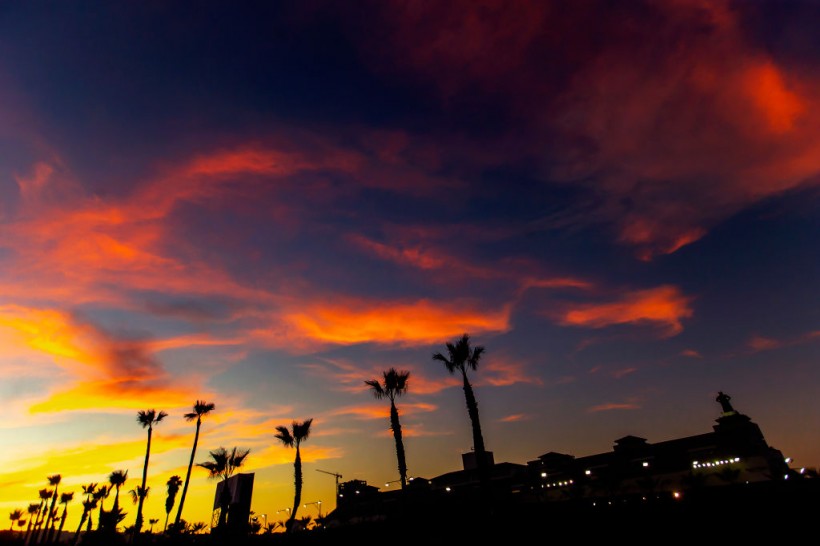
Researchers at UC San Diego School of Medicine said the so-called "drug tourism" could be fueling a new HIV outbreak in Tijuana, Mexico.
In the Conference on Retroviruses and Opportunistic Infection on Friday, the researchers noted that the HIV incidence rate among people who use drugs in Tijuana had risen to an unprecedented 11 per 100 100 person-years, which translates to 11 percent per year, Fox 5 News reported .
On the other hand, the HIV incidence rate for people using drugs in San Diego who cross the U.S.-Mexico border to buy drugs was found to be lower. However, it was still high compared to the HIV incidence rate among drug users who do not cross the southern border.
Steffanie Strathdee, associate dean of Global Health Sciences, said the rising rate happened when the U.S.-Mexico border was closed to nonessential travel between March 2020 and November 2021.
Strathdee noted that people in the U.S. travel to Mexico, often for long periods, to buy and use cheaper and more accessible drugs. She said the undiminished "drug tourism" drove it.
Strathdee noted that viruses do not require passports to spread, adding that "walls" do not keep out infectious diseases. She then went on to say that there is a need to boost HIV prevention efforts on both sides of the border.
READ NEXT: Mexican National Guard Troops to Be Deployed in Cancun, Other Popular Resorts in Mexico As Violence Rises
HIV Outbreak in Tijuana, Mexico
For years, HIV incidence in Tijuana, Mexico had been stable or declining, partly due to a multi-million dollar effort by the Global Fund for HIV, according to Medical Express . However, that funding reportedly ended in 2013.
Some Mexican government funding to community-based groups that provide HIV services to marginalized populations was also reduced in 2019. The COVID-19 pandemic in 2020 also diverted more funds away from HIV prevention and treatment efforts.
Gudelia Rangel, a co-director of this study and a researcher at El Colegio de la Frontera Norte and U.S.-Mexico Border Health Commission, noted that it is vital to understand that public health issues like this are "binational in nature."
Rangel said viruses do not stay in one place, so there is a need to work closely with partners on both sides of the border to find enough resources.
The researchers said the findings highlight the urgency of restoring and expanding efforts on the matter, such as mobile needle exchange programs and greater access to health services and medicines that can significantly reduce the chances of HIV infection for persons at high risk.
Drug Tourism in Mexico
Drug tourism in Mexico has also brought drug cartels to tourist spots in the country, with dealers arriving at the beachside resort outside Cancun last month.
Violence had started in the tourist spots, with shootings between rival drug cartels emerging. According to Washington Post , one security footage shows attackers running from the beach toward the $400-a-night hotel while tourists in bathing suits were trying to take cover in hallways.
Lucio Hernández Gutiérrez, the security chief for Mexico's Quintana Roo state, said the main reason the cartels are swarming tourist spots is because of the large demand for drugs, especially among travelers. The security chief added that it was a "very difficult thing to stop."
In October, a German and Indian tourist was killed by gunmen in Tulum . The following month, a shooting occurred at the Hyatt Ziva Riviera Cancun, leaving two cartel members dead.
READ MORE: Armed Men Stormed Cancun Resort As Tourists and Staff Take Shelter; Shooters Suspected Drug Dealers in Mexico
This article is owned by Latin Post.
Written by: Mary Webber
WATCH: Tourists Flee From Gunfight At Mexican Luxury Resort - From TODAY
Subscribe to Latin Post!
Sign up for our free newsletter for the Latest coverage!
Tags HIV outbreak , drug tourism , Tijuana , Mexico , Illegal Drugs , Mexican Drug Cartels , mexican drug cartel , drug cartels , Drug Cartel

+1 (703) 566-9463 | Emergency Support
- Duty of Care Membership
- Air Ambulance - Medical Evacuation
- Travel Guardian Platform
- Kidnap, Ransom, & Extortion Services
- Real-time Video Surveillance
- Digital Infrastructure Protection
- Business Continuity & Training
- Drone Technology
- Emergency Response
- Executive Protection & Transportation
- Emergency Aviation
- Event Security
- Global Intelligence
- K9 Security Solutions
- Family Membership
- Study Abroad
- Air Ambulance Medical Evacuation
- Home Monitoring
- Travel Security
- Executive Protection
- Medical Assistance
- Video Surveillance
Global Digest
- Global Guardian Academy
About Global Guardian
Executive Leadership
Global Coverage

Risk Map 2023 Analysis: Mexico Cartel War
The following analysis is part of Global Guardian's 2023 Risk Assessment Map. To explore and download the map, click here .
The drug war in Mexico is one of the most violent conflicts on the planet with cartel activity permeating through many levels of the Mexican economy and society. Cartel conflicts continue to drive violence across Mexico, including tourist areas previously less affected, such as Cancun and Puerto Vallarta. Inter-cartel violence can impact and disrupt travel, worksites, and supply chains.
PRIMARY Actors
Cartel Jalisco Nueva Generacion (CJNG) , based out of Jalisco state, is the emergent power in Mexico, and it controls or fights for territory in Guanajuato, Michoacan, Baja California, Mexico, Jalisco, Chihuahua, and Guerrero, among other locations across the country. The CJNG engages in drug trafficking (primarily synthetics, including methamphetamine and fentanyl), kidnapping, extortion (particularly of avocado & lime farmers), oil pipeline tapping, and other criminal activities in the Tierra Caliente region.
Sinaloa Cartel (CDS) once the dominant drug trafficking organization in Mexico, has faced challenges and challengers to its primacy in the last several years, notably from the CJNG but also from splintering factions and subsequent in-fighting. The CDS has reportedly broken into several major factions: one led by Ismael “El Mayo” Lambada, El Chapo’s number two; another by the brother of El Chapo, Aurelio “El Guano” Guzmán Loera; and another led by El Chapo’s four sons, known collectively as “Los Chapitos.” Fighting amongst these groups and the CJNG has contributed to much of the violence in Mexico, particularly in the west and northwest of the country.
The current criminal landscape in Mexico is driven largely by the battle between the Cartel Jalisco Nueva Generacion (CJNG) and the Sinaloa Cartel (CDS), though three other major transnational criminal organizations (TCOs), Los Zetas , Gulf Cartel , and Juarez Cartel , all contribute to high levels of violence.
The CJNG, is responsible for much of the uptick in violence over the last several years as it acts on its expansionist goals. The above-mentioned seven states accounted for over half of the national total of homicides in the first six months of the year. The leader of the CJNG, Nemesio “El Mencho” Oseguera Cervantes, is the most wanted man in Mexico, with a $10,000,000 U.S. Drug Enforcement Agency (DEA) bounty on his head. Unlike the leader of CDS, Joaquin “El Chapo” Guzman, El Mencho has managed to escape capture by federal authorities. His son “El Menchito” was not so lucky; however, in a show of brazen force, the CJNG killed the federal judge overseeing his case who had approved El Menchito’s extradition to the U.S.
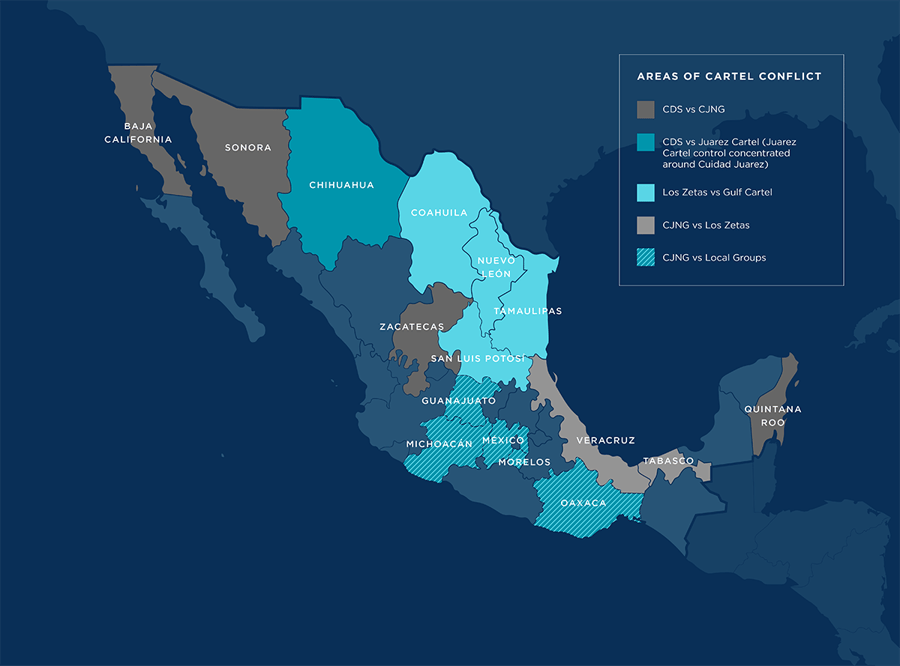
CURRENT STATE
August of 2022 saw a significant increase in cartel-related violence across multiple areas of Mexico, including in Tijuana, Ciudad Juarez, Guanajuato, and Guadalajara. Overnight on 09 August, violence erupted in Guadalajara and Guanajuato after the arrest of high-ranking CJNG member "El Doble R" on 09 August. Cartel members clashed with security forces, set fire to at least 25 OXXO convenience stores, and set several vehicles ablaze to prevent the passage of security forces. At least three people were killed, 19 vehicles destroyed, and 11 suspects arrested.
On 11 August, at least 10 people were killed in Ciudad Juárez after suspected cartel members attacked multiple fast-food restaurants and convenience stores. The attacks were linked to deadly gang clashes that occurred at a Ciudad Juárez prison (Cereso No. 3) earlier in the day. Overnight on 12 August, violence broke out across northern Baja California, including in Tijuana, Mexicali, Ensenada, and Rosarito. Multiple vehicles, including buses and taxis, were car-jacked and set ablaze, forming burning blockades. Multiple convenience stores were targeted for arson as well in an effort to cause chaos and divert emergency services. It is believed that CJNG members carried out the blockades in response to the arrest of "El Doble R" in Guadalajara several days before. At least 17 people were arrested in connection with the burning blockades.
As a result of the violence in Tijuana, the Mexican Army sent 350 soldiers and National Guard personnel to the city to be deployed across Baja California state to help shore up security. A similar deployment occurred in the Quintana Roo area last year following an uptick in cartel violence in Cancun, Tulum, Playa del Carmen, and Cozumel.
Further violence can be expected following future arrests of any high-ranking cartel members; however, the Mexican government may be less willing than ever to arrest cartel leadership following the events of August in Guadalajara, Tijuana, and elsewhere. Similarly, in 2019, one of El Chapo’s sons, a leader of “Los Chapitos”, was arrested. His arrest caused the CDS to mobilize a large force to wreak havoc on the Sinaloa capital of Culiacan. Security forces released him after orders came down from high-ranking government officials. This highlights not just the power of violence, but the power of corruption and influence, a hallmark of the CDS.
ESCALATION TRIGGERS
- Arrest of high-ranking cartel members
- Murder of high-ranking cartel members
- Additional fracturing of TCOs into splinter groups
- Aggressive expansion into territory controlled by rival cartel
Sectoral Impact
- Manufacturing
- Pharmaceuticals
- Oil & Gas
*Analysis last updated September 2022
The Global Guardian team is standing by to support your security requirements in Mexico. To learn more about our Duty of Care membership, as well as secure car and driver, custom intelligence reporting, and emergency response services, click below to contact Global Guardian's 24/7 Operations Center or call us directly at +1 (703) 566-9463.

Check Out Our Latest Updates
Global guardian's michael ballard featured in border report, global guardian's zev faintuch featured in newsweek, iran launches attack on israel, subscribe here sign up today to receive monthly articles curated by the global guardian team on relevant and important safety and security topics..

Corporate Solutions
Personal Solutions
Government Solutions
Traveler Security
Asset Security
Cyber Security
Customized Security
Case Studies
+1 (703) 566-9463
Request Security
Emergency Support
Travel Agents & Affiliates
STAY CONNECTED
© Copyright 2024 Global Guardian. All Rights Reserved. | Privacy Policy | Do Not Sell or Share My Personal Information | Privacy Rights Request Form | XML Sitemap | HTML Sitemap
Global Guardian needs the contact information you provide to us to contact you about our products and services. You may unsubscribe from these communications at any time. For information on how to unsubscribe, as well as our privacy practices and commitment to protecting your privacy, please review our Privacy Policy.
- Skip to main content
- Keyboard shortcuts for audio player
Health Care
The 4 kidnapped americans are part of a large wave of u.s. medical tourism in mexico.
Bill Chappell
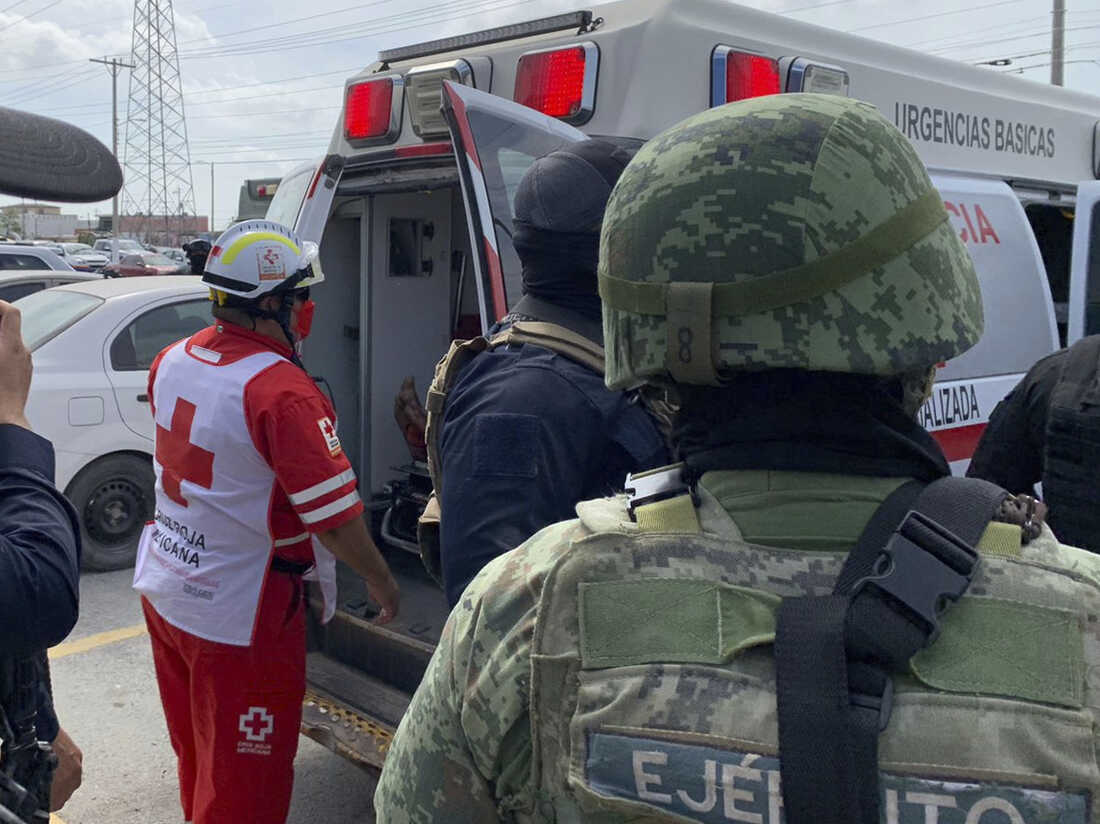
A Red Cross worker closes the door of an ambulance carrying two Americans found alive after they were abducted in Matamoros, Mexico, last week. Two of four Americans have been found dead, after they were caught in a cartel shootout, officials said Tuesday. AP hide caption
A Red Cross worker closes the door of an ambulance carrying two Americans found alive after they were abducted in Matamoros, Mexico, last week. Two of four Americans have been found dead, after they were caught in a cartel shootout, officials said Tuesday.
The four Americans who were shot at and abducted in Mexico were reportedly visiting for medical tourism — making them part of a booming industry that is vital to Mexico's economy.
"Pre-pandemic, some 1.2 million American citizens traveled to Mexico for elective medical treatment," Josef Woodman, CEO of Patients Beyond Borders , told NPR. His firm publishes a guide to international medical travel.


Latin America
2 surviving americans who were kidnapped in mexico are back in the u.s..
Here's an update on medical tourism, and the recent tragedy:
U.S. medical travel is rising sharply
"Today, the market is recovering rapidly in Mexico, nearly back to its pre-pandemic levels," Woodman said.
Nearly 780,000 people were projected to leave the U.S. for health care in 2022, according to Healthcare.com , citing data from the medical travel website Medical Departures.
Medical tourism in Mexico isn't new, but the recent tragedy put it in the spotlight
Medical tourism in mexico isn't new, but the recent tragedy put it in the spotlight.
That outburst of activity got a big boost in late 2021, when the U.S. relaxed key border restrictions with Mexico.
Costa Rica is the second-most popular destination for U.S. visitors seeking medical care elsewhere, Woodman said. It's a particular draw, he added, for people in the Northeast and Southeast.
Most people travel for dental and cosmetic work
Cosmetic surgeries are just one of the procedures that are far cheaper in Mexico — for years, people have been visiting from the U.S. to get elaborate dental work or cosmetic treatments done, or to pick up antibiotics and other medicines at favorable prices.

Shots - Health News
A reason to smile: mexican town is a destination for dental tourism.
Many people also travel to get orthopedic work done, replacing knees or hips for less than half the cost of such procedures in the U.S.
"North American patients travel to Mexico for care primarily to save 50-70% over what they would pay in the United States for an elective treatment," according to Woodman.
Medical tourism does bring risks, experts say
While an element of risk is inherent in many procedures no matter where they're performed, medical tourism can heighten complications, according to the Centers for Disease Control and Prevention.
Potential problems range from the dangers of flying in a pressurized plane cabin too soon after a surgery to the complications of getting follow-up care for a procedure done in another country.
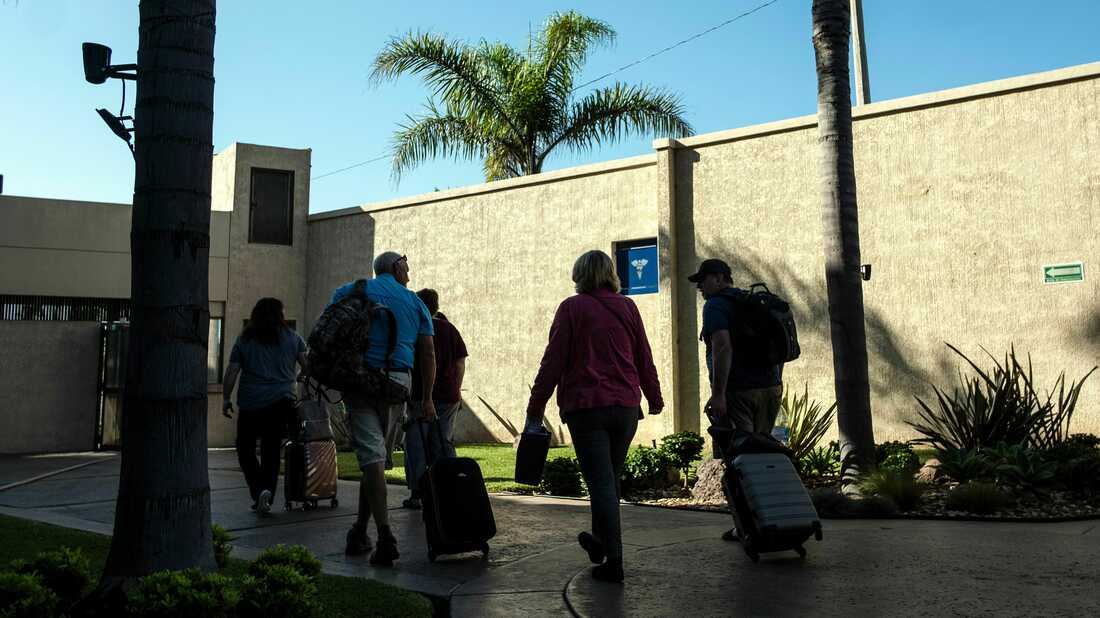
Medical tourism numbers are on the rise in Mexico, after the practice was curtailed by COVID-19 restrictions. Here, foreign patients are seen at the hospital Oasis of Hope in Tijuana in, 2019, in Mexico's Baja California state. Guillermo Arias/AFP via Getty Images hide caption
Medical tourism numbers are on the rise in Mexico, after the practice was curtailed by COVID-19 restrictions. Here, foreign patients are seen at the hospital Oasis of Hope in Tijuana in, 2019, in Mexico's Baja California state.
Some of the most serious warnings from the CDC are for infections, from wound and blood infections to pathogens that might be more common or resistant in the host country than in the U.S.
"Recent examples include surgical site infections caused by nontuberculous mycobacteria in patients who underwent cosmetic surgery in the Dominican Republic," the CDC says, "and Q fever in patients who received fetal sheep cell injections in Germany."
U.S. medical tourists rate Mexico highly
A 2020 research paper that surveyed some 427 Americans crossing the U.S.-Mexico border in California for medical services found that most of the respondents "felt that Mexican health care services are of the same or better quality compared with those in the United States, for a lower cost."
People had come from 29 states across the U.S. to get care in Mexico, with the vast majority driven by cost concerns, according to the paper, published in the Journal of the American Pharmacists Association .

Hit with $7,146 for two hospital bills, a family sought health care in Mexico
The researchers also collected data about the medical tourists themselves, reporting an average age of 64.5 years. Their most common yearly income range was reported to be between $25,001 and $50,000 — but that reflects less than a quarter of the respondents.
More than 400 of the survey's 427 participants said they would undertake more medical tourism in the future, the paper said.
Most of Mexico's hospitals follow U.S. standards
Mexico has worked for years to promote medical tourism to draw patients across the U.S. border. That includes improving its health system and following international standards.
"About 10 years ago, the Mexican federal government licensed the Joint Commission accreditation standards, which are used to accredit U.S. hospitals," as David Vequist, who runs the Center of Medical Tourism Research at the University of the Incarnate Word in San Antonio, told NPR's All Things Considered .
"So most Mexican hospitals are now basically using the same standards we use in hospitals in the United States," Vequist added.
Details of the recent violence are still emerging
At least one of the U.S. citizens who were caught up in the recent tragedy was reportedly going to Mexico for a tummy tuck operation. But the group's vehicle came under fire hours after entering the border city of Matamoros, Mexico, from Brownsville, Texas.
Two of the four died; all are reported to be natives of Lake City, S.C. Their identities have not been released, but relatives have been speaking to NPR and other outlets .
Mexican officials say they believe the four were caught in the middle of a conflict between drug cartels in the state of Tamaulipas — an area that is under a do-not-travel advisory from the U.S. State Department.
- Medical tourism
latest in US News

NYC firefighter dies of heart attack after being fired to pay for...

Harvard anti-Israel protesters fly Palestinian flag in spot...

Beloved pooch hit by stray bullet in NYC home dies of injuries:...

Columbia students celebrate as school officials promise no...

NYC illegal pot shop worker boldy defiant as officials question...

'Midtown Jane Doe' finally ID'd -- thanks partly to eerie twist...

Trump holds comfortable lead over Biden despite legal woes — as...

Sands official rips NY for slow-walking state gaming licenses...
Cartel expert recommends tourists ‘don’t go’ to mexico right now.
- View Author Archive
- Email the Author
- Follow on Twitter
- Get author RSS feed
Contact The Author
Thanks for contacting us. We've received your submission.
Thanks for contacting us. We've received your submission.
The hand-printed signs, in neat block letters, appeared in the Tulum marketplace the morning after two tourists were shot dead and three others wounded at a roadside eatery in the bohemian Mexican resort town.
“Attention merchants of Tulum … this was a warning,” said the sign, which went on to threaten “managers and owners” of bars and restaurants on the “Mini Quinta” tourist zone. That’s where the foreigners, visiting the Malquerida Bar last month, had the bad luck of getting caught in cartel crossfire.
The signs were photographed by a local citizens’ advocacy group, which posted them to social media. The message threatened death to merchants who refuse to fork over bribes to the drug-trafficking gangs and was signed by Los Pelones — “the bald ones.”

The gang has been a longtime enforcer of the Gulf Cartel, whose battle against their archrivals — the ferocious Jalisco New Generation Cartel and Sinaloa Cartel — has recently resulted in shocking gangland-style violence along the Riviera Maya, a sun-drenched stretch of beaches on the Yucatan Peninsula that is Mexico’s biggest tourist hub.
Things have become so dangerous that on Wednesday, Mexico’s President Andres Manuel Lopez Obrador announced the creation of a “tourist battalion” — 1,500 National Guard soldiers wielding automatic weapons to keep visitors safe.
Beginning next month, the soldiers will be stationed in Cancun and surrounding areas, including Tulum, where Mexican law enforcement said there are 10 groups fighting for drug dominance in the picture-postcard resort town.

On Oct. 21, US travel blogger Anjali Ryot , 25, and German tourist Jennifer Henzold, 35, were gunned down in the Tulum shooting. Two weeks later, dozens of tourists were forced to scramble for cover when 15 gang members, their faces hidden by ski masks, went on a daylight shooting rampage on a beach in the village of Puerto Morelos, south of Cancun, killing two suspected traffickers.
“What we’re seeing is a huge increase in street fighting from the plaza bosses,” Texas-based security consultant Robert Almonte, an expert on Mexican cartels, told The Post. “That’s how they respond when rivals come onto their turf. They don’t lose any sleep over who they shoot. And if there are innocent bystanders, too bad. That’s the way they think.”

In addition to the 10 outfits fighting to control drug sales in the “plazas” or drug marketplaces of Tulum, there are two other gangs in Cancun fighting for dominance of the Riviera Maya, according to Oscar Montes de Oca, the lead prosecutor in the state of Quintana Roo, where Cancun, Puerto Morelos and Tulum are located.
State governor Carlos Joaquin called the recent beach commando raid “a serious blow to the development and security of the state … putting the state at grave risk.” With turf wars increasing among rival cartels, homicides in the state rose from 145 in 2015 to 628 in 2020 — a 333 percent increase in a place where 75 percent of the local economy is based on tourism , according to Mexican statistics.
“Mexico is not doing anything to fix the problem,” Almonte told The Post. “My concern is that, as a tourist, you are not going to be the target, but you might be sitting at a table next to a target, and suddenly that vacation becomes your last.”

The Jalisco New Generation Cartel was founded in 2009 by Nemesio Oseguera Cervantes (“El Mencho”), who is among the most wanted drug traffickers on the planet after the 2014 arrest of Joaquin “El Chapo” Guzman, head of the Sinaloa cartel. The US Drug Enforcement Administration has listed a $10 million bounty for El Mencho’s capture.
Jalisco is among the main producers of the fentanyl and methamphetamine that is smuggled to the US. It’s also become the most feared of the Mexican drug gangs.
Cartel members last year tried to assassinate Omar Garcia Harfuch , Mexico City’s chief of police, in an attack that wounded him and left three people dead, including two of his bodyguards. In 2015, they shot down a military helicopter with a rocket-propelled grenade .

In 2015, Oseguera’s son Rubén Oseguera González, known as El Menchito, was arrested on drug-trafficking charges and last year he was extradited to the US , where he awaits trial.
And this week, the group was hit with a real blow, according to Almonte: Mexico’s military arrested Rosalinda González Valencia, the wife of Cervantes.
The woman known as “La Jefa” — the chief — was Jalisco’s main accountant, part of a subgroup known as Los Cuinis, Almonte said. Arrested in an upscale Guadalajara neighborhood on Monday, Gonzalez Valencia is charged with laundering money for the cartel.
“Who knows what kind of information she will give to authorities,” Almonte told The Post.
While it’s unclear whether the high-profile arrest will lead to the Jalisco Cartel’s retreat, the rival Gulf Cartel also faces challenges with the recent death of their leader, Ariel (“El Tigre”) Trevino Pena, who was killed by the Mexican army in a shootout in Matamoros in October.

The Gulf Cartel — among the oldest criminal enterprises in Mexico — is mired in infighting, according to security experts.
Founded by Juan Nepomuceno Guerra Cárdenas in the 1930s in Matamoros, the Gulf Cartel first smuggled alcohol across the border during Prohibition. Later, the operation expanded to include gambling, prostitution and theft. The ’80s saw Gulf focus on cocaine and marijuana trafficking, followed by fentanyl and other synthetic drugs — not to mention racketeering and human trafficking at the border, according to Mexican and US authorities.
The Gulf Cartel also has cells in some border towns in Texas, and alliances with mobsters in Italy.
And then there is the Sinaloa Cartel. With El Chapo sentenced to life imprisonment at a maximum-security prison in Colorado, the group is now run by Ismael “El Mayo” Zambada Garcia, 73.

Zambada Garcia, who headed up his own eponymous criminal operation before joining the Sinaloa Cartel alongside El Chapo, is reportedly in ill health and in hiding. In September, the State Department tripled the reward for information leading to his capture from $5 million to $15 million.
Earlier this month, the State Department announced a $5 million bounty for information leading to the arrest of four Sinaloa drug traffickers, including Aureliano Guzman Loera, who is known as “El Guano” and is the older brother of El Chapo.
With longtime kingpin El Chapo gone, things have been a bit messy in the organization, which smuggles a wide variety of drugs, including opioids. In addition to battling their enemies in the Jalisco and Gulf cartels, they are fighting among themselves for control, said Almonte.
“Right now you have factions fighting for leadership within the Sinaloa Cartel to control the sale of opioids, and you have the larger cartels all fighting each other,” he told The Post. “It’s a mess.”

All the violence comes at a time when Mexico is trying to bolster its tourism sector, which accounts for 8.5 percent of the country’s gross domestic product. In 2019, that amounted to more than $25 billion generated from 45 million tourists, according to Mexico’s National Tourism Business Council. During the height of the pandemic last year, the country’s tourism revenues plummeted by more than 50 percent.
Despite the uptick in violence at tourist destinations and the deployment of troops, Lopez Obrador said the country is forging ahead with ambitious plans to construct an international airport in Tulum by 2023, as well as a 900-mile train route that would link resort spots in Quintana Roo to some of the region’s far-flung historic and ecological sites.

“Tulum will keep growing because the Mexican government is really investing in tourism here,” said Susann Rottloff, a Tulum-based realtor and German expatriate who has lived in Tulum for the last three years. “People keep asking me if Tulum is safe. I am a single woman and I’ve never had a problem, and Tulum is packed right now.”
Despite last month’s shootings, visitors continue to flock to the resort town. More than 140,000 descend on the region every week, according to Mexican government statistics, with many wanting to invest in property for the long term, Rottloff told The Post this week.
“I feel extremely safe here,” said a Dutch expatriate, who just closed on a home in the area. The 63-year-old entrepreneur, who did not want to be identified by name, said he has been vacationing in Tulum for more than 10 years, and bought his first condo in the seaside resort town overlooking the azure waters of the Caribbean Sea two and a half years ago.
“I feel safer here than I do in Los Angeles,” he said, adding that after the October shootings, the Mexican government dispatched 450 National Guard soldiers to Tulum to keep the peace.

“I think the government took a lot of security measures after it happened,” he said, adding that authorities also cracked down on drug trafficking in the area. “For a number of months you would go to a restroom in a restaurant and there would be some guy with a backpack trying to sell you drugs. That’s all gone now. The government has gotten really serious about cracking down on crime.”

Despite the recent spate of drug violence, Tulum’s foreign residents are staying put.
“Well, we’re still doing business in real estate,” said Rottloff. “It’s [the recent violence] definitely concerning but it’s all relative. Other places in the world are far more violent.”
But for Almonte, who organizes seminars for US law enforcement on Mexican cartels, “things are out of control and the Mexican government does not have a handle on it,” he said. “I’m asked a lot about travel to Mexico, and my recommendation is don’t go.”
Share this article:

Advertisement
Drug violence scares off tourists to Mexico
- Medium Text
Our Standards: The Thomson Reuters Trust Principles. New Tab , opens new tab


- Focus Areas
- Publications
- The Indigenous World
- Indigenous Debates
- Organisation
- Our Projects
- Contact IWGIA
- IWGIA i Danmark
The tourism industry and drug trafficking in Mexico: from the perspective of the Mayan Peoples
Written on 29 April 2022 . Posted in News
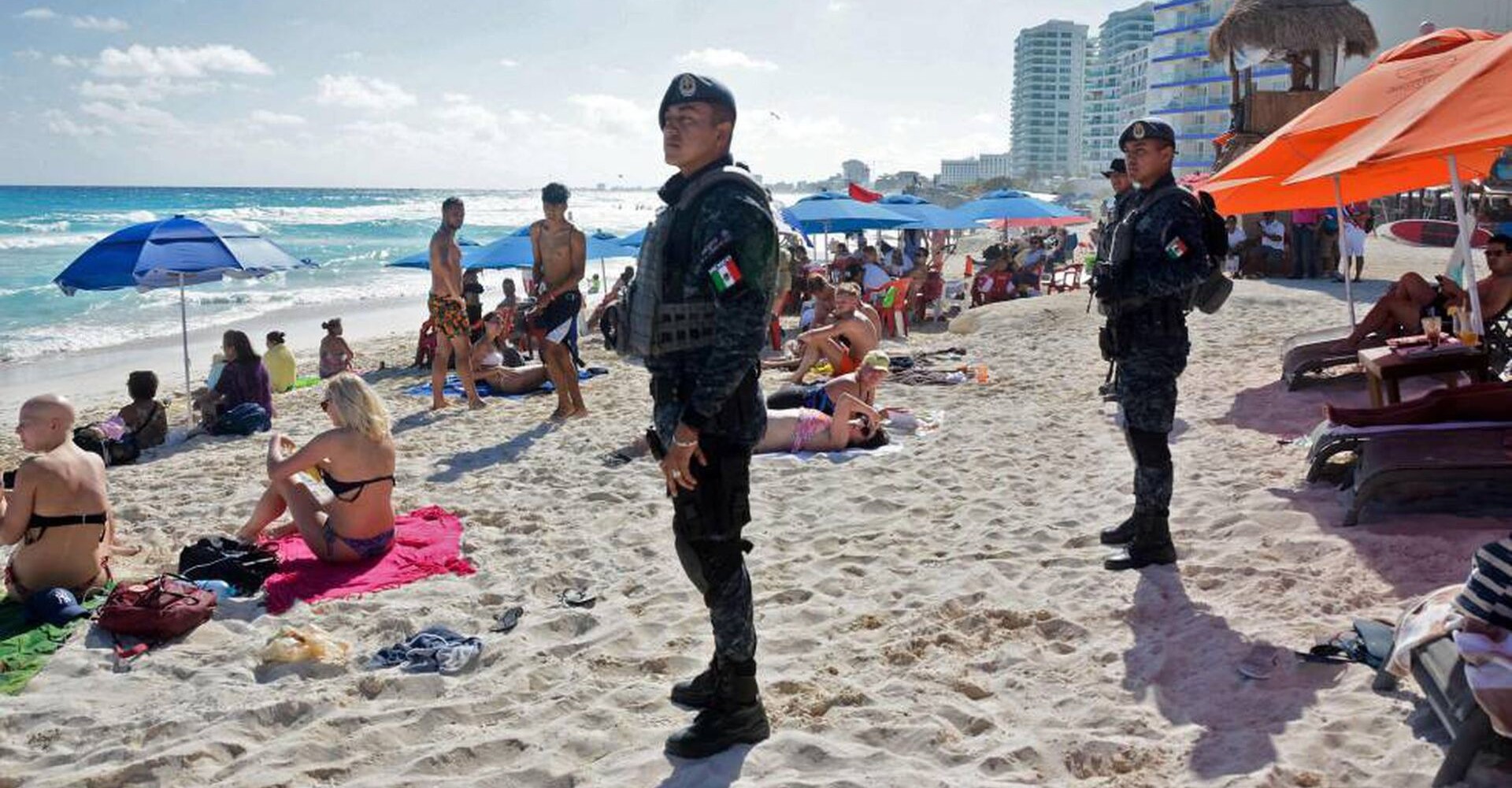
BY ANGEL SULUB FOR DEBATES INDÍGENAS
Before the advance of the presence of the State, the Maya Máasewáal nation lived in times of abundance. However, schools began teaching that the milpa was “poor man´s” work, whiles mass tourism turned the Mayas into a source of cheap labor. The arrival of tourists to cities such as Cancun, Playa del Carmen and Tulum resulted in a market for drug trafficking and drug dealing in the region. In the same light, the mega-project of the (misnamed) Mayan Train is bound to have destructive consequences for nature. At the same time, the tourism industry will expand to rural regions that until now have lived from the production of the land and have not suffered from organized crime. Hope lies in community organization, resistance and struggles for the defense of the land.
Five decades have been enough to (once again) transform the lives of the Mayan peoples of Mexico in a significant and alarming manner. In 1970, the creation of the Cancun Project turned the Yucatan Peninsula into the main center of tourist development in the country and one of the most important in the world. The promotion of mass tourism on the Caribbean coast was yet another blow to the Mayan autonomies that up until 1940 had maintained territorial control of the region.
Based on their own forms of political, spiritual, military and commercial organization, the Maya peoples managed to keep the Mexican State, which they had resisted since 1850 (three years after the great armed uprising of the Maya, known as the Caste War ), on the sidelines. The Mexican military incursions were intended to invade the center of the Maya government: the town of Noj Kaj Santa Cruz Xbáalam Naj K'ampokolche' (now called Felipe Carrillo Puerto).
The Maya Máasewáal nation remained free and outside of the political life of Mexico. In this way, they strengthened their communal ways of working the land, maintained the rituals in their ceremonial centers which united them as an autonomous people, deepened their commercial relations with British Honduras (now Belize) and put into practice their diplomacy to enter into agreements with other states and expel the Mexicans from their territory.

Map of the Yucatan Peninsula prepared in 1861. Source: Manuel Orozco y Berra Map Library
Memories of abundance
The grandmothers of the Mayan villages tell how they lived their childhood and youth in abundance and wealth. Their parents and grandparents worked in the milpas (small traditional farming plot including maize) and never lacked food. In the milpa they grew corn, beans, tomatoes, pumpkins, chili peppers, sweet potatoes, jicama, yucca, lentils, and other tubers. In the plots of the houses, there was an endless number of fruit trees, foods, and medicinal plants. On top of that, animals were also raised in the houses.
The harvest satisfied the food needs and what was left over was sold in the markets of nearby towns. The money from the sale was enough to purchase fabrics and supplies to embroider the colorful hippiles worn by the women and the men's costumes. It was common to see the women wearing gold chains and luxurious filigree earrings and the men wearing their finely elaborated suits and hats. Maya clothing holds a strong spiritual symbolism. Unfortunately, the abundance of the past stands in stark contrast to the present condition of the increasingly impoverished and exploited Maya peoples.
Education also took place in the milpa, which was the space for work, rituals, socialization, and learning. The children and youth were guided by the grandparents in their love for the land, the seeds, and the sense of community. The grandmothers say that misery began when the school imposed by the Mexican State arrived: the teachers taught that the milpa was for “poor people” and that, to get ahead and better oneself, it was necessary to study and find a good job.
Today, the “good job” that the system offers the Mayan is typically that of an office job in a large hotel owned by some Spanish enterprise. The truth is, however, that it is a slavish job in which rehearsed smiles are exchanged for generous tips. Today, tips are the main source of income for most Maya workers in the tourism sector.
The death industry
With the creation of Cancun and the emergence of new tourist centers such as Playa del Carmen and Cozumel, the hell of criminality also made its way into the Mayan territory. For the Mayan people, tourism represented the violent transition from self-sufficiency to dependence on service sector labor, such as working front desks in hotels, waitering in restaurants or vending on the beach.
The tourist industry meant a rupture with ancestral life: from the dismantling of forms of cultivation to the breaking of relations between communities. Sacred spaces were renamed as "archaeological zones" and became tourist attractions for travel agencies. Tourism forced the migration of youth to the new urban centers and, gradually, the Mayan milpa, which had since ancestral times served as the most sacred and essential space for community life, was abandoned.
The Maya became the source of a cheap labor force that now sustains the urban centers. It is the Mayans who build the hotels, the houses, the roads, and all the infrastructure that supports the tourist industry. It is the Mayans who serve in the restaurants, clean the beaches, and wash the public toilets. The Mayans are servants in the same territory that was taken from them. It is also the Mayans who now live through the hell of criminality - from childhood they are tempted into drug consumption, drug dealing, and drug trafficking controlled by the cartels that have taken control of the cities.
Along with the mass tourism, urbanity and “progress ” that came with capitalism to Mayan lands, arrived the drug cartels, human trafficking, extortionist mafias and sex tourism. Just like the tourism companies, these criminal groups come to take their slice of the economic profits stemming from the appeal of the sun and the beach of the Mexican Caribbean.
Tourism and drug trafficking
The city of Cancun and the Riviera Maya have become true paradises for tourism and partying, but also for drug dealing. The presence of drugs in every nightclub, bar, restaurant, beach, and shopping mall has impacted the social dynamics of the popular and marginal areas of the city. In this way, they have become territories of dispute, settling of scores, forced disappearances and executions for the control of drug plazas (turfs).
In recent years, this growing and unstoppable violence springing from drug trafficking has reached areas previously considered violence-free. In 2021, shootings were recorded in Cancun's hotel zone, in Playa del Carmen's Quinta Avenida, and in restaurants in Tulum and Puerto Morelos which were crowded with tourists. In all these cases, people were killed and wounded, including tourists, locals, and drug dealers. The increase in crime has already caused countries such as Germany and the United States to warn their citizens about the risks of visiting the Mexican Caribbean.
The presence of drug cartels in Quintana Roo is not limited to urban and tourist areas. In recent years, their presence has reached the rural regions where they control the passage of drugs coming from Central and South America. In these territories where the Mayan peoples still live, violence has taken hold. In Felipe Carrillo Puerto, the sacred ancient city and capital of the Mayan people, 13 executions were perpetrated during 2019 – unheard of for this community. These murders occurred due to the arrival of a drug cartel that drove local drug dealers out of the plaza . This situation has repeated itself in other places where tourism is accelerating, such as Bacalar. In this town known for its crystal-clear lagoon, two international and one local cartel have established agreements with local governments to maintain community order.
In the south of Quintana Roo, on the border with Belize and Guatemala, a strategic corridor has been established for the arrival of drug planes bound for Mexico and the United States. For the Mayan communities, this situation has led to a breakdown of their community fabric as the co-optation of agrarian authorities to facilitate the landing of airplanes has triggered serious internal conflicts. Likewise, the dispute over territory has provoked the forced displacement of a group of inhabitants of the Maya Balam community, who are former refugees from Guatemala's civil war (1960-1996) . Four decades later, they are facing the beginning of a new armed conflict unleashed by drug trafficking.
The train that is not mayan
The largest megaproject currently being imposed in the southeast of Mexico is the so-called Tren Maya (Mayan Train), the most important project for the current government. The touristic passenger and freight train is intended to cross five states: Chiapas, Tabasco, Campeche, Yucatan, and Quintana Roo. Along its 1,500 kilometers, it will connect the tourist resorts of Cancun and Playa del Carmen; archeological zones such as Calakmul in Campeche, Chichen Itza in Yucatan, and Tulum in Quintana Roo; and colonial cities such as Merida and Campeche. In this way, the train will pass through nature reserves and rural communities .
This megaproject, whose execution began in 2020, violates the rights of self-determination of the Mayan peoples. An indigenous consultation should have been carried out, as established by the ILO Convention 169, considering the significant impact on the communities the project is bound to have. However, the office of the United Nations High Commissioner for Human Rights has stated that the consultation has not been properly carried out . In addition, the project violates national laws and regulations related to nature, the right to a healthy environment, as well as the right to information and of citizen participation.
The (misnamed) Mayan Train aims to replicate the Cancun and Riviera Maya models in those rural regions which possess exceptional natural assets. The project will create at least 19 cities with a tourist vocation. The environmental, social, cultural, and economic impact is overlooked, not to mention the increase in crime and drug trafficking. While tourism development generates immeasurable economic activity, this industry mainly benefits transnational corporations that invest in the developmental model of large hotels, energy companies, agribusiness, and real estate.
In the World Travel & Tourism Summit of the World Travel & Tourism Council held in Cancun in April 2021, the Ministry of Tourism of Quintana Roo reported that significant investments from the world’s leading hotel groups had been announced: "It is estimated that by 2022 our destinations will be able to provide more than 120,000 hotel rooms; prospecting a tourism investment of more than 2.3 billion dollars" . Tourism growth is the region's main economic policy, but the tourists’ demand for drugs will inevitably transfer the violence of criminal groups to these territories.
From hell to hope
In geopolitical terms, the Yucatan Peninsula is a region of relevance for the United States. In this context, drug trafficking cannot be understood without paying attention to the phenomenon of touristification: tourists are an extremely attractive market for drug cartels. To the increase in violence and criminality, we must add the arrival of mega-projects financed by transnational corporations, which generate serious environmental, economic, and cultural damage.
In recent decades, the Mayan peoples of Quintana Roo have experienced the dispossession of their lands, the imposition of new logics of life, the modification of their social dynamics related to the planting and cultivation of corn, the dependence on the tourism sector that enslaves them, and the normalization of violence exercised by criminal cartels – both in the cities and now in rural areas. The Mayan peoples have seen how their ancestral territory has become a disputed territory for the control of drug transit and plazas for drug sales .
Despite this bleak panorama, there is still hope. Hope lies in the communitarian organization, in the resistance and in the struggles for the defense of the land. It is in every farmer who grows corn, in every Mayan-speaking person, and in every organization and collective that works for the good life of the people. All of the anti-capitalist and anti-colonial efforts that are being articulated in the Mayan territory today nourish hope.
Angel Sulub is a Mayan delegate to the Congreso Nacional Indígena de México ( National Indigenous Congress of Mexico ) .
Tags: Global governance , Indigenous Debates
STAY CONNECTED
About IWGIA
IWGIA - International Work Group for Indigenous Affairs - is a global human rights organisation dedicated to promoting and defending Indigenous Peoples’ rights. Read more.
For media inquiries click here
Indigenous World
IWGIA's global report, the Indigenous World, provides an update of the current situation for Indigenous Peoples worldwide. Read The Indigenous World .
Subscribe to our newsletter
Prinsessegade 29 B, 3rd floor DK 1422 Copenhagen Denmark Phone: (+45) 53 73 28 30 E-mail: [email protected] CVR: 81294410
Report possible misconduct, fraud, or corruption
NOTE! This site uses cookies and similar technologies.
If you do not change browser settings, you agree to it. Learn more
The head of Mexico's detective service says his country is the 'champion' of fentanyl production
The head of Mexico's detective service has acknowledged the country is “the champion” of fentanyl production, which appears to run counter to past statements by President Andrés Manuel López Obrador
MEXICO CITY -- The head of Mexico ’s detective service acknowledged Tuesday that the country is “the champion” of fentanyl production, something that appears to run counter to past statements by President Andrés Manuel López Obrador.
López Obrador has hotly denied in the past that any fentanyl is produced in Mexico, saying Mexican cartels only press it into pills or add finishing touches.
But Felipe de Jesus Gallo, the head of Mexico’s Criminal Investigation Agency, said that since the 1990s “Mexico has been the champion of methamphetamine production, and now fentanyl.” He spoke at a U.S.-Mexico conference on synthetic drugs in Mexico City.
Experts agree that cartels in Mexico use precursor chemicals from China and India to make the synthetic opioid and smuggle it into the United States, where it causes about 70,000 overdose deaths annually.
While fentanyl is not widely abused in Mexico, methamphetamine addiction is commonplace.
Gallo said that Mexican cartels have launched industrial-scale production of meth in many states throughout the country and now export the drug around the world.
“Believe me, methamphetamine production has become industrialized, it's not just in the mountains anymore,” Gallo said. “We now expect to see (drug) laboratories not just in the mountains of Sinaloa and Sonora, but in Hidalgo as well, Puebla, and also in Jalisco."
He was apparently referring to thousands of drug labs detected in previous years in the hills and scrublands around Culiacan, the capital of the northern state of Sinaloa. Those clandestine, rural production sites were often bare-bones, improvised labs covered with tree branches and tarpaulins.
Now, the meth trade has become so lucrative and so sophisticated that Mexican meth is exported as far away as Hong Kong or Australia , and the cartels have found ways to avoid detection of their drug money.
“The business models have become very innovative, or as old and antiquated as barter; ‘I’ll trade you precursor chemicals for meth,' to avoid leaving a money trail,” Gallo said.
There is little question that drug production goes on at a huge scale in Mexico.
In February, Mexico's Navy seized over 45 tons of methamphetamine at the biggest drug lab found during the current administration. The lab was in Quiriego, a township in a remote part of the northern border state of Sonora.
The 91,000 pounds (41,310 kilograms) of meth found there was more than half of the 162,000 pounds of the drug Mexico has seized so far this year.
Fentanyl production is also huge, though because it is a more potent drug, the volume is smaller.
A year ago, soldiers seized more than a half-million fentanyl pills in Culiacan in what the army at the time described as the largest synthetic drug lab found to date.
Soldiers found almost 630,000 pills that appeared to contain fentanyl, the army said. They also reported seizing 282 pounds (128 kilograms) of powdered fentanyl and about 220 pounds (100 kilograms) of suspected methamphetamine.
López Obrador, who took office on Dec. 1 2018, also claims that Mexicans are culturally immune to drug addiction.
Top Stories
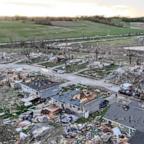
5 killed, including baby, as tornadoes slam the heartland

3 police officers shot in Louisiana in fatal standoff with gunman: Officials

Biden jokes about past stumbles, digs at Trump during annual correspondents' dinner
- Apr 28, 11:12 AM

Eagles QB Jalen Hurts donates $200,000 for AC units in Philadelphia schools
- Apr 28, 1:16 PM
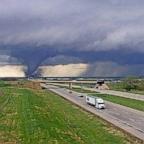
Tornados leave trail of destruction as 4 injured, hundreds of homes damaged
- Apr 28, 8:47 AM
ABC News Live
24/7 coverage of breaking news and live events
- Election 2024
- Entertainment
- Newsletters
- Photography
- Personal Finance
- AP Investigations
- AP Buyline Personal Finance
- AP Buyline Shopping
- Press Releases
- Israel-Hamas War
- Russia-Ukraine War
- Global elections
- Asia Pacific
- Latin America
- Middle East
- Election Results
- Delegate Tracker
- AP & Elections
- Auto Racing
- 2024 Paris Olympic Games
- Movie reviews
- Book reviews
- Personal finance
- Financial Markets
- Business Highlights
- Financial wellness
- Artificial Intelligence
- Social Media
Mexico’s chief detective apologizes for saying his country is the ‘champion’ of fentanyl production
Workers unpack medicine at a “mega-pharmacy” warehouse on its inauguration day in Huehuetoca, Mexico, Dec. 29, 2023. A new report released by the Mexican government Friday, April 12, 2024, says the country is facing a dire shortage of fentanyl for medical use, even as Mexican cartels pump out tons of the illicit narcotic. (AP Photo/Fernando Llano, File)
- Copy Link copied
MEXICO CITY (AP) — The head of Mexico’s detective service apologized Thursday for saying his country is “the champion” of fentany l and meth production.
The comments Tuesday by Felipe de Jesus Gallo, the head of Mexico’s Criminal Investigation Agency, appeared to contradict past statements by President Andrés Manuel López Obrador, who has denied any fentanyl is produced in Mexico.
Gallo’s office cited a report of the comments by The Associated Press, and acknowledged that Gallo “used an inadequate word,” but didn’t specify whether the offending word was “champion.”
“It is clear that this word, which was reported by AP and a Mexican media outlet, was inadequate,” his office said. “For that reason, Mr. Gallo publicly apologizes, and explains that his intent, in which he clearly shouldn’t have used the word, was to emphasize the long battle that our country has had to carry out against the production, export and shipment of synthetic drugs.”
Gallo’s comments at a U.S.-Mexico conference on synthetic drugs in Mexico City Tuesday drew López Obrador’s ire at his daily news briefing Thursday.
The president has long claimed that Mexican cartels only press it into pills or add finishing touches, and he demanded that Gallo’s office explain the comments, calling them “alarmist.”
Gallo originally said that since the 1990s “Mexico has been the champion of methamphetamine production, and now fentanyl.”
Experts agree that cartels in Mexico use precursor chemicals from China and India to make the synthetic opioid and smuggle it into the United States, where it causes about 70,000 overdose deaths annually.
While fentanyl is not widely abused in Mexico, methamphetamine addiction is commonplace.
Gallo said Mexican cartels have launched industrial-scale production of meth in many states throughout the country and now export the drug around the world.
“Believe me, methamphetamine production has become industrialized, it’s not just in the mountains anymore,” Gallo said. “We now expect to see (drug) laboratories not just in the mountains of Sinaloa and Sonora, but in Hidalgo as well, Puebla, and also in Jalisco.”
He was apparently referring to thousands of drug labs detected in previous years in the hills and scrublands around Culiacan, the capital of the northern state of Sinaloa. Those clandestine, rural production sites were often bare-bones, improvised labs covered with tree branches and tarpaulins.
Now, the meth trade has become so lucrative and so sophisticated that Mexican meth is exported as far away as Hong Kong or Australia, and the cartels have found ways to avoid detection of their drug money.
There is little question that drug production goes on at a huge scale in Mexico.
In February, Mexico’s Navy seized over 45 tons of methamphetamine at the biggest drug lab found during the current administration. The lab was in Quiriego, a township in a remote part of the northern border state of Sonora.
The 91,000 pounds (41,310 kilograms) of meth found there was more than half of the 162,000 pounds of the drug Mexico has seized so far this year.
Fentanyl production is also huge, though because it is a more potent drug, the volume is smaller.
A year ago, soldiers seized more than a half-million fentanyl pills in Culiacan in what the army at the time described as the largest synthetic drug lab found to date.
Soldiers found almost 630,000 pills that appeared to contain fentanyl, the army said. They also reported seizing 282 pounds (128 kilograms) of powdered fentanyl and about 220 pounds (100 kilograms) of suspected methamphetamine.
- Visit Oyster on Facebook!
- Visit Oyster on Pinterest!
- Visit Oyster on Instagram!
- Visit Oyster on Twitter!
- Subscribe to stay up to date!
Yes, send me expert tips and deals!
By proceeding, you agree to our Privacy Policy and Terms of Use .
- Subtract one room 1 Rooms Add one room
- Subtract one adult 2 Adults Add one adult
7 Destinations Where Drug Tourism Is Thriving
See recent posts by Megan Wood
A destination's reputation for drugs can deter tourists who worry about safety and violence. But drug access (whether illegal, legal, or somewhere in between), and the party culture that comes with it, can also work as a hook to draw both the curious and the initiated. Of course, it's important to be aware of all drug laws while traveling and know that penalties can be severe. We took a look at how drug tourism is thriving and impacting these seven popular tourist destinations.
1. Ayahuasca in Peru
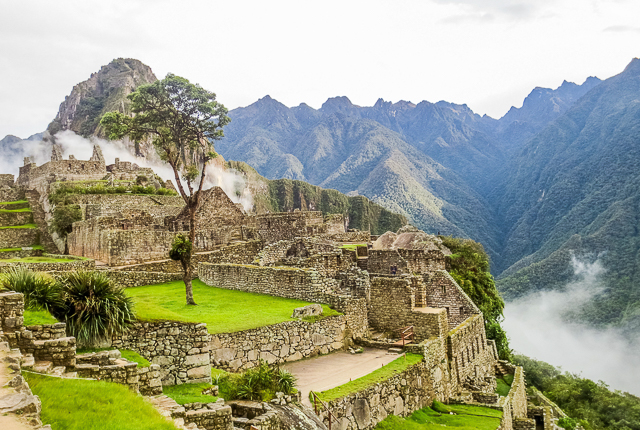
Machu Picchu /Oyster
A growing number of Westerners are heading to the jungles of Peru (and Ecuador, Brazil, and Colombia) to experience an Amazonian ayahuasca ceremony, usually led by a shaman. Ayahuasca is a hallucinogen made from a specific blend of Amazonian plants that are mixed into a drinkable elixir. The drink has been used in medicinal and spiritual rituals for centuries by indigenous cultures who believe in ayahuasca’s psychological healing properties. But in the last decade, Western travelers have been especially keen to imbibe and possibly cure their past traumas, addiction, or emotional baggage on a psychedelic plane. The Guardian estimates that there are around 100 ayahuasca centers in Iquitos alone that cater to foreign travelers (and the vomit that usually comes with consuming the drug). Packages range from an overnight visit to a month-long spiritual retreat. Though many studies have shown ayahuasca to be safe, and even beneficial, there have been reports of fake shamans, sexual assaults, and death affiliated with the drug. Ayahuasca is legal in Peru and illegal in the United States.
2. Hashish in Morocco
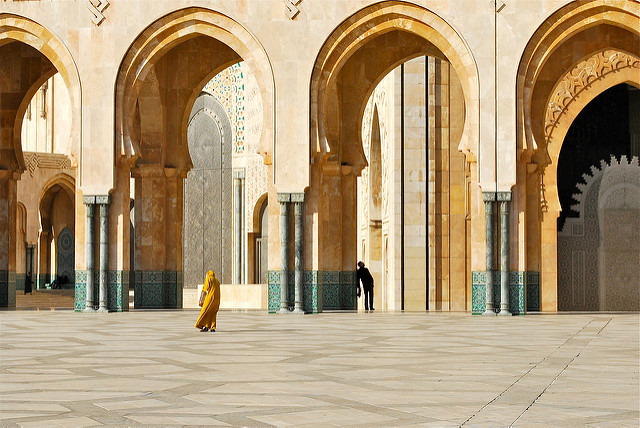
Nathan Guy/Flickr
Smoking hashish (or kif, in local parlance) is a common pastime among Moroccan males and tourists of both sexes. Many backpackers look to Morocco’s easy availability of the drug as a main reason to visit stoner-friendly towns like Chefchaouen . According to Vice , Morocco produces half of the world’s hashish and the illegal industry employs around 800,000 people. Hordes of young men work as unofficial hash guides, taking interested tourists to hash farms and teaching them about production before getting them ripped. Hash looks like sticky brown clay and is usually broken up and mixed with tobacco for smoking in a paper like a cigarette, or in a hookah pipe. But just because it’s widespread, doesn’t mean it’s legal. Smoking illegal drugs (or carrying them) can incur a 10-year prison sentence.
3. Cocaine in Colombia
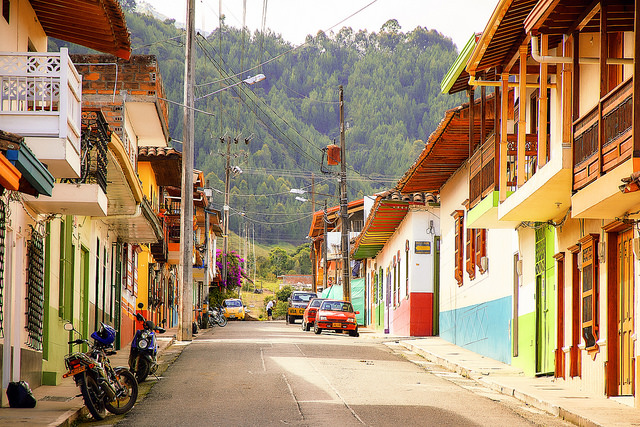
Pedro Szekely/Flickr
In the early 1990s, Medellin was the murder capital of the world. The city recorded 381 murders per 100,000 residents in 1991, and the presence of paramilitary groups and the Medellin cartel made the entire place look and feel like a war zone — a drug war zone led by the notorious Pablo Escobar. In 2015, Medellin saw only 20 murders per 100,000 residents, continuing the steady trend of declining violence and the promotion of a flourishing and stable economy. And though locals seem more than ready to forget about the city’s recent, brutal past, many tourists choose to visit Medellin for a safe taste of notoriety — and cocaine. El Poblado, one of the city’s wealthiest and safest neighborhoods, is incredibly popular for Poblado Escobar Tours and procuring baggies of cocaine from men who also sell candy and gum on picturesque street corners. The arrest of tourists for cocaine possession is exceedingly rare, but the city’s citizens (many of whom lost at least one friend or family member in the violent ’90s) are less than enthused by wealthy visitors who treat the once violent city as a safe drug playground.
4. Marijuana in Colorado
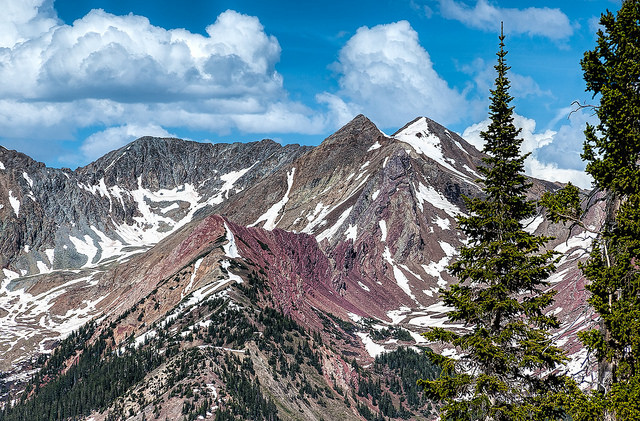
Sheila Sund/Flickr
The state of Colorado legalized marijuana for recreational purposes in 2012. Though easier access to pot has drawn significantly more visitors to the state, there have been problems. It’s still illegal to smoke pot in public and in most hotels, and many visitors don’t realize they’re not allowed to fly or drive out of the state with drugs. One of the biggest problems is over-ingesting edible marijuana. The Chicago Tribune reported that out-of-state visitors to Colorado emergency rooms for marijuana-related symptoms accounted for 163 per 10,000 visits in 2014. Visitors consume edible marijuana in the form of pastries and candies, and essentially dose themselves with too much THC, causing heart palpitations and anxiety attacks.
5. Marijuana in the Netherlands
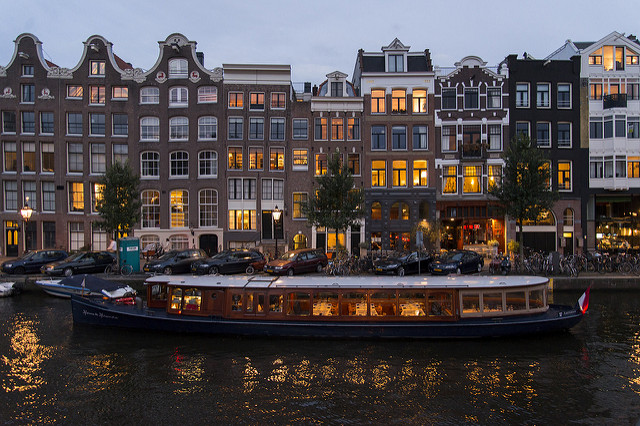
BriYYZ/Flickr
Recreational drugs are illegal in the Netherlands , but the Dutch parliament decriminalized possession of less than five grams of cannabis in the 1970s, allowing for an upsurge in “coffee shops” that sell pot, and (mostly) allow customers to light up. Some estimates say that 90 percent of coffee shop customers are foreigners and there are occasional threats to shut the whole system down. But with millions of coffee shop visitors a year, the financial toll would be high and the Dutch are well-known for allowing individual freedoms. Amsterdam even has a Hash, Marijuana & Hemp Museum that celebrates the history of cannabis.
6. Coca in Bolivia
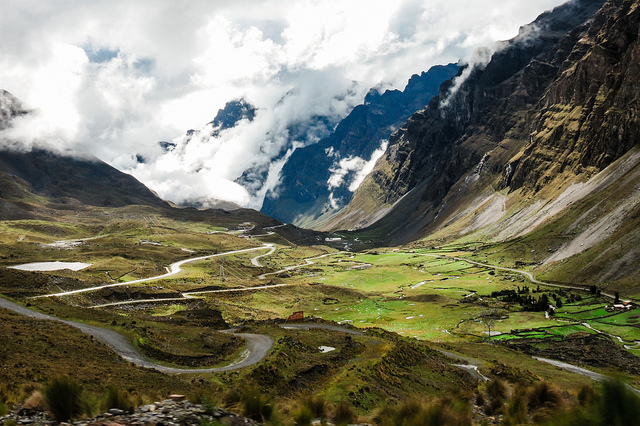
Matthew Straubmuller/Flickr
The coca leaf, of which cocaine derives, is considered a sacred commodity in Bolivia, where Andean people have chewed the leaf for thousands of years to relieve altitude sickness and get an energy boost that’s equivalent to a cup of coffee. President Evo Morales legalized coca cultivation after he was elected in 2006, arguing that indigenous peoples should not be robbed of their ancient crop and traditions. Coca is generally harmless, but cocaine is not. And Morales’ liberal coca leaf policy has bolstered illegal cocaine use in Bolivia, particularly among foreigners who appreciate the high quality of the drug for an insanely low cost. Route 36 is a notorious underground and ever-moving cocaine and cocktail bar that doesn’t allow Bolivians inside in an effort to keep out undercover cops and journalists.
7. Mushrooms, Ecstasy, and Opium in Laos
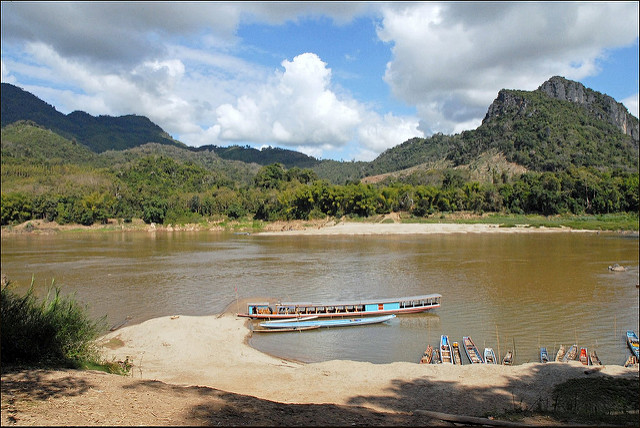
Jean-Pierre Dalbéra/Flickr
The drug culture is strong and can be all-consuming among expats and long-term backpackers throughout Southeast Asia. Full moon parties in Thailand , Vietnam, and Indonesia are usually fueled by ecstasy, Molly, and mushrooms that keep partiers dancing and tripping until the sun rises. But the largest concentration of drugs in Southeast Asia can arguably be found in Vang Vieng, Laos, which is well-known for its lazy river, where (usually young and covered in body paint) visitors are given free shots of booze and sold a variety of drugs. The floating party is experienced by inner-tubes, tree swings, and slides into the water. Bars line the shores, and it’s easy and cheap to buy the drug of choice. Death by drowning, overdose, and broken necks are yearly occurrences, but the known danger doesn’t seem to stop the hordes of partygoers looking for a good time.
You’ll Also Like:
- 9 International Tourist Attractions that Would be Illegal in the U.S.
- 5 Minor Offenses That Will Have You Serving Hard Time Abroad
- Ayahuasca: Why Travelers Swear by this “Trip” of a Lifetime
All products are independently selected by our writers and editors. If you buy something through our links, Oyster may earn an affiliate commission.
Top Stories

- Travel Tips
Top 11 Las Vegas Hotels on the Strip for Every Type of Traveler
By Christina Vercelletto

- Dominican Republic
Hotel Face-Off: Excellence Punta Cana vs. Excellence El Carmen
By Megan Wood

12 Things to Ask for When You Check Into Your Hotel Room
By Toby Orton

- Travel Safety
The 11 Safest Travel Destinations in the Caribbean Right Now
By Lilly LeClair

We Made a List of the Top 8 Psychedelic Retreats in Mexico
- Share on Facebook
- Share on Twitter
- Share on WhatsApp
- Share on Pinterest
- Share on LinkedIn
Mexico's rich cultural heritage, stunning landscapes, and deep-rooted psychedelic traditions make it an ideal destination for transformative retreats and inner exploration. Here is a list of 8 retreats found in Mexico that offer transformational experiences through plant medicines like psilocybin, ayahuasca, 5-MeO-DMT, and ibogaine.
Mexico, with its vibrant culture, breathtaking landscapes, and deep spiritual traditions, has become a sought-after destination for those seeking profound inner experiences through psychedelic retreats . With a long history of psychedelic use in indigenous communities that spans millennia, Mexico can be regarded as a sacred land where ancient wisdom intertwines with contemporary psychedelic exploration. In this article, we delve into some psychedelic retreats in Mexico that offer a safe and supportive environment for personal growth and exploration using substances like psilocybin, ayahuasca , 5-MeO-DMT, or ibogaine. Whether you’re a seasoned psychonaut or embarking on your first psychedelic journey, these retreats can provide a gateway to self-discovery, healing, and transformation among some of Mexico’s most scenic places.
You may also like: The Most Affordable Psychedelic Retreats Out There
Table of Contents
Beond | Cancún | Ibogaine

Found in the tropical haven of Cancún, Beond is an odd combination between a luxury retreat, a medical facility and a wellness center that treats some of the hardest cases of addiction, trauma and depression. Beond specializes on ibogaine as a plant medicine and has over 80 years of collective experience with it. Led by a team of experienced doctors, along with facilitators and adjunct therapists, Beond has decades of experience successfully treating thousands of people and their families who sought to heal trauma and chemical dependency. Some of the conditions they have treated include alcoholism and addiction to fentanyl, opiates, stimulants, Suboxone, and more. Aside from treating addiction, the team also treats mood disorders such as depression, anxiety, and trauma. Beond seamlessly blends the professionalism of a licensed, credentialed medical facility with the purpose-driven environment of a mental health treatment center, the inspiration and innovation of a psychedelic retreat, and the comforts of a luxury resort.
RELATED: Find Psilocybin Retreats Near You
Eleusinia | Valle de Bravo | Psilocybin & DMT
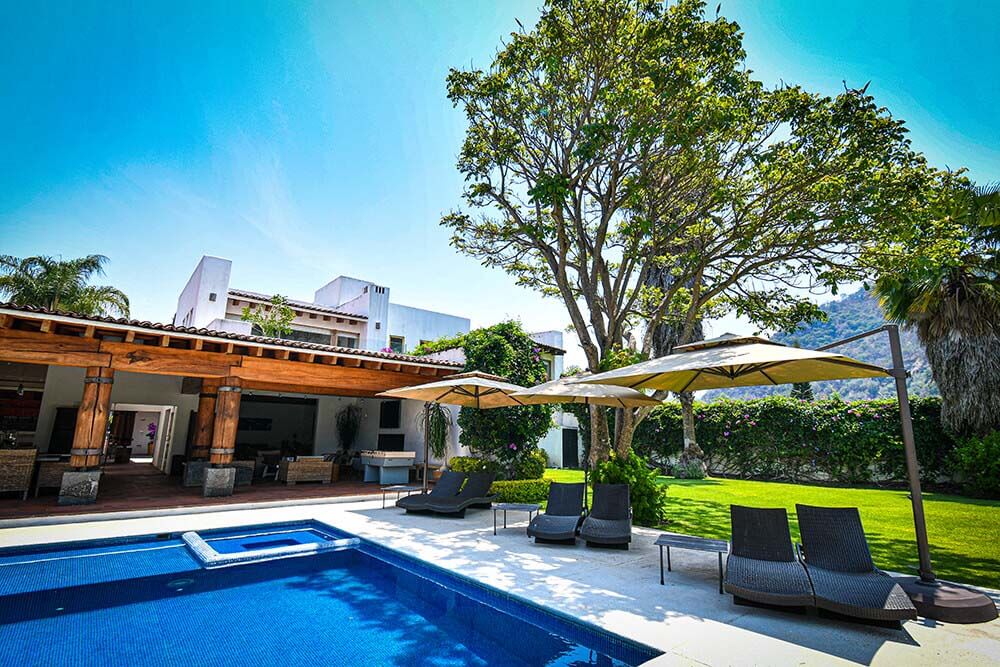
Eleusinia Retreat offers a nature-centered environment for a psychedelic experience. Source: Eleusinia
Eleusinia Retreat is found in the tranquil mountains of Valle de Bravo, Mexico. Eleusinia offers a serene and welcoming environment for small, intimate groups to experience the transformational powers of psilocybin mushrooms. Their retreat features a comfortable 6-bedroom villa that embraces the natural beauty of its surroundings. Their sessions all take place in their lush garden, allowing guests to connect with nature while embarking on their journey. The retreat also offers a thoughtfully curated menu prepared by an in-house gourmet chef that consists of three exquisite courses featuring traditional Mexican and continental dishes. Their 5-day retreat includes a 5-15 gram dose of mushrooms, a 1-3 gram dose session, and a 1-on-1 DMT session facilitated by an indigenous curandera from Oaxaca.
IbogaQuest | Tepoztlán | Ibogaine

IbogaQuest is a different type of retreat, focusing on providing healing through ibogaine. Source: IbogaQuest
With 12 years in business, IbogaQuest is renowned for its transformative retreats centered around iboga, a powerful psychedelic plant known for its potential in addiction recovery. Located in the ceremonial grounds of Centro Werika in Tepoztlán, a high mountain valley an hour and a half away from Mexico City, IbogaQuest is situated in an ancient town that overlooks a pyramid central to the cultural life of the community. With a team of experienced iboga providers, IbogaQuest offers a safe and supportive environment for participants to embark on a deep introspective journey through a careful screening process along with pre- and after-care sessions. They are very set on providing a safe setting and only offer the highest quality ibogaine assayed and certified to be > 98% pure. Their experienced team includes qualified therapists, body-workers, addiction specialists, and medical supports, while always working under the supervision of an experienced local doctor.
Life Synergy Retreat | Playa del Carmen | Psilocybin Mushrooms

Life Synergy retreats offer psilocybin and San Pedro experiences in a safe, supportive environment. Source: Life Synergy
Found in the beautiful city of Playa del Carmen, Life Synergy Retreat offers a transformative space for individuals seeking healing and personal growth through sacred plant medicines. With a focus on psilocybin ceremonies, their experienced facilitators guide participants on a journey of self-discovery, spiritual exploration, and emotional healing. The retreat also offers occasional San Pedro cactus ceremonies, as well as included, yet optional, DMT ceremonies derived from a native Mexican tree called Tepezcohuite. The retreat offers an array of activities in their itinerary such as a sound bath, breathwork, swimming in a cenote, yoga classes, homemade meals, and transportation to and from each activity.
One Spirit Infinite Journeys | San Jose del Pacifico | Psilocybin Mushrooms

One Spirit Infinite Journeys offer psilocybin experiences facilitated by experienced guides. Source: One Spirit Infinite Journeys
One Spirit Infinite Journeys is a company that offers psilocybin and ayahuasca retreats in Mexico and in Costa Rica, respectively. Their psilocybin retreat is held at San Jose Del Pacifico, a town that is famously known for its mushroom use. If anything, you can consider San Jose Del Pacifico the mushroom capital of Mexico.
Their 8 days and 7 nights retreats offer two mushroom ceremonies, a temazcal (sweat lodge) session, emotional healing workshops, sound baths, breathwork, rape ceremony, integration support, cacao ceremony, meditation, vegetarian meals, transportation, and, for an additional cost, a massage with a their in-house massage therapist.
Nestled in the enchanting Mountains of San Jose Del Pacifico, Refugio Terrazas de la Tierra, the retreat center, embraces the captivating beauty of its surroundings. With a strong commitment to veganism, the center offers an array of delectable plant-based options for breakfast, lunch, and dinner, sourcing most of its ingredients from the land it harmoniously resides on. Embracing a sustainable lifestyle, the retreat center operates on a self-sustaining solar power system, inviting guests to disconnect from modern society and rediscover the pure joys of life.
Samskara Retreats | Tulum or Cancún | Ayahuasca
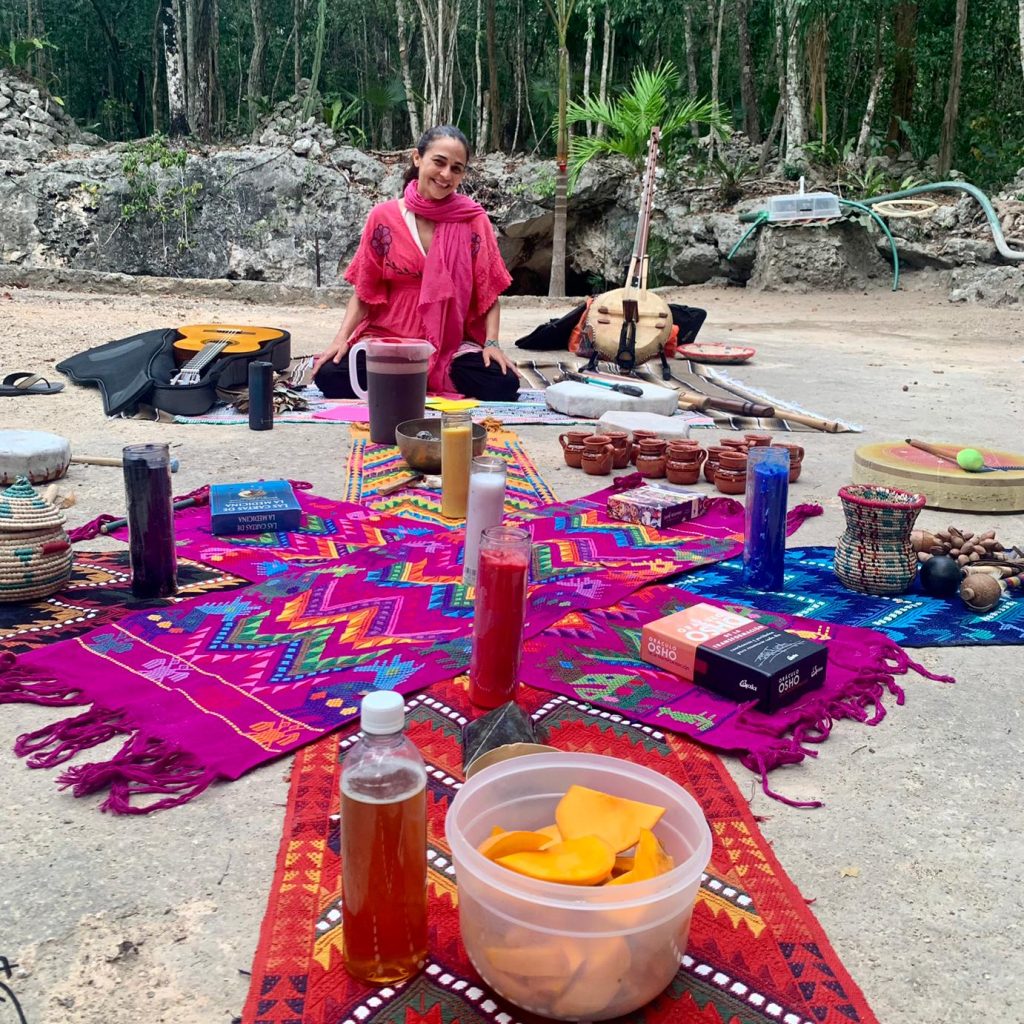
Samskara Healing Retreats offer the transformative power of ayahuasca in their retreats. Source: Samskara
Nestled in the tropical paradise of Tulum and Cancún, Quintana Roo, Mexico, Samskara Retreats offers a sanctuary for personal exploration and spiritual evolution. Combining ancient wisdom with contemporary therapeutic practices, their retreats focus on ayahuasca retreats. Each retreat package includes 6 days and 5 nights in Tulum or Cancun (depending on which city is available), 2 ayahuasca ceremonies, 1 temazcal, rape, an herbal medicine bath, a 1-hour massage, energetic activation, shamanic guided journey, cacao ceremony, somatic release breathwork session, cleansing in a cenote, integration sessions, homemade vegetarian meals, free WiFi, and transportation to the venue.
Sayulita Wellness Retreat | Nayarit | Psilocybin Mushrooms
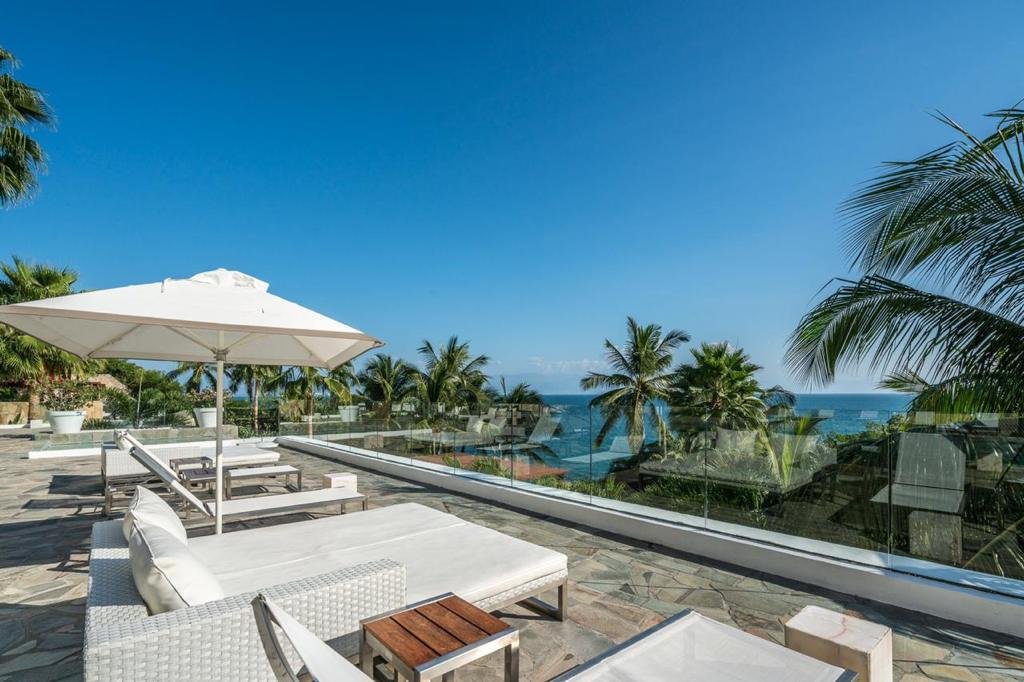
Sayulita Wellness offers a luxury high-end psychedelic experience using psilocybin mushrooms. Source: Sayulita
Sayulita Wellness Retreat , located in the beautiful secluded beach town of La Cruz de Huanacaxtle, Nayarit, offers a holistic approach to psychedelic exploration in a luxury retreat setting. With a focus on psilocybin mushroom ceremonies, their retreats provide a safe and supportive environment for emotional healing, personal growth, and self-discovery. Their total staff of 15 professionals have provided over 10,107 successful psychedelic treatments. The center’s tranquil setting, nourishing homemade cuisine, and experienced facilitators contribute to a transformative and rejuvenating experience.
Each platinum 7-day retreat includes helicopter sighseeing, sunset sailing through Bay of Banderas, hypnotherapy, skydiving, scuba diving at Majahuitas Cove, a dinner show, sound therapy, anti-inflammatory homemade cuisine, private ocean view suite, three healing massages, three yoga and somatic movement classes, Wim Hof breathwork and ice bath, 4 weeks of aftercare calls, and three psilocybin sessions: one private macro dose (3.5-7.0g) and two micro doses (200-800mg).
Tandava Retreats | Tepoztlán | 5-MeO-DMT

Tandava offers a unique experience for those seeking psychedelic healing by using 5-MeO-DMT as its main psychedelic medicine. Source: Tandava
Located in the scenic landscape of Tepoztlán, a mere 90-minute drive from Mexico City, Tandava offers 5-MeO-DMT retreats that allow you to explore the deepest realms of your consciousness. Their 5-day individual retreats include 2 weeks of prep work via Zoom before arrival, biofeedback and neurofeedback sessions, artesian market trip, mountain hike, Temezcal session, daily yoga, meditation, and breathwork, access to hot tub, steam sauna, and pool, 4 integration sessions post-retreat, and healthy meals prepared with fresh local ingredients with your dietary requirements.
Tandava utilize synthetic 5-MeO-DMT to provide more accurate and precise dosing, as well as to respect the Bufo toads and ensure the sustainability of the drug. Each participant undergoes a pre-screening process to ensure that it is safe for them to sit with the medicine. The retreat is only led by experienced practitioners and teachers who have dedicated years to mastering and navigating 5-MeO-DMT as a medicine. Each retreat comes with an integration protocol, ensuring that each participant can gets a lasting impact from the retreat on their daily life, long after the medicine has faded.
Final Thoughts
Embarking in psychedelic retreats in Mexico can be a profound and life-changing experience. The retreat centers mentioned above offer a safe and supportive environment for individuals to explore the realms of consciousness, heal emotional wounds, and facilitate personal growth. Whether it’s ayahuasca, psilocybin mushrooms, iboga, or other sacred plant medicines, these retreats provide a gateway to self-discovery, inner transformation, and spiritual awakening. Remember to research each retreat center thoroughly, choose the one that resonates with your intentions, and always prioritize safety and integration to make the most of your experience with psychedelic retreats in Mexico.
Leave a Reply
Your email address will not be published. Required fields are marked *
Related News
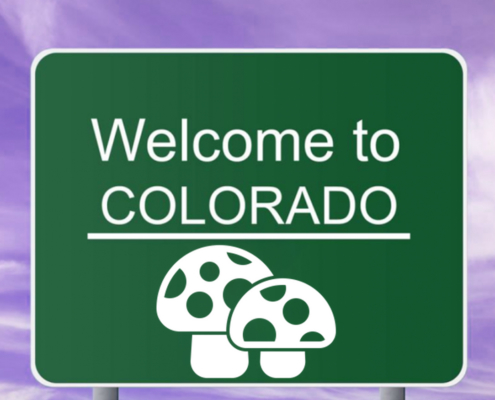
Psychedelic Decriminalization is on the Ballot in Colorado

First Neuroimaging Study of Psilocybin Microdosing Underway in Sydney

Texas Further Embraces Psychedelics with Launch of Center for Psychedelic Research and Therapy
Psychedelic Spotlight is your reliable source for the latest stories in the emerging psychedelics industry, covering breakthrough discoveries, investor news and cultural reform.
- Advertise With Us
- Privacy Policy
- Terms and Conditions
- Conferences
Get a roundup of Psychedelic news stories in your inbox
By signing up to the Psychedelic Spotlight newsletter you agree to receive electronic communications from Psychedelic Spotlight that may sometimes include advertisements or sponsored content.

IMAGES
VIDEO
COMMENTS
Tourists are an easy target for drug cartels, analysts say, particularly if they've come to sample the drug scene. TULUM, Mexico - With its turquoise waters, white sand and ancient ruins, this ...
Danger in the restrooms. Two Tulum-based business owners who asked to remain anonymous for fear of retaliation from the cartels said the city's tourism has blossomed after the worst of the ...
Alcohol consumption laws. The legal drinking age is 18 in Mexico, and while passengers of the requisite age aren't prohibited from drinking inside a vehicle, it's illegal to drink in the street, and visitors can be fined or jailed for public inebriation. Driving while drunk in Mexico is, of course, a criminal offense.
For that reason, officials say, Mexico's two biggest drug trafficking organizations, the Sinaloa Cartel and the Jalisco New Generation Cartel, both based on the other side of the country, have ...
PUERTO MORELOS, Mexico — The shooting of two suspected drug dealers at a resort on Mexico's Caribbean coast is part of a fight among about a dozen gangs to carve up the lucrative market of ...
By Frédéric Saliba (Mexico City (Mexico) correspondent) Published on June 29, 2022, at 7:40 pm (Paris), updated on June 29, 2022, at 7:40 pm. Time to 7 min. Lire en français. Share Share. Share ...
Security experts weigh in. Karol Suárez. September 29, 2022 · 11 min read. 418. A member of the newly created Tourist Security Battalion of the National Guard stands guard at a beach in Cancun, Quintana Roo State, Mexico, on December 2, 2021. - On November 17, Mexico created a "tourist battalion" of 1,500 National Guard police officers to ...
Last month, guests at a resort 100km up the coast near Cancún rushed for cover after masked gunmen stormed a hotel beach by boat and opened fire, killing two suspected rivals. The two attacks are ...
Mr. de Hail recommends researching the resort and news from the area you're visiting. The U.S. State Department provides state-by-state information about travel risks in Mexico. As of early ...
The Secretary of Tourism for Mexico reported a 76 percent increase of passengers on international flights with Mexico between January 2021 and November 2021, compared to the same period in 2020. But since late 2021, that appeal was tarnished by negative press coverage of violent incidents either directly involving tourists or occurring near ...
Mexican authorities have been waging a deadly battle against drug cartels for more than a decade, but with limited success. Thousands of Mexicans—including politicians, students, and journalists ...
With tourism the main legal source of income for Mexico, with an estimated 66 million people visiting in 2022 alone, violence around resort towns used to be a rarity up until 15 years ago.
In fact, tourism accounts for 87% of their GDP (Valenzuela & Tendian, StoryMaps). Drug distribution is a major issue in Quintana Roo as well. Drug cartels cater items such as Mexican-grown cannabis, Colombian pot, or other local drugs to tourists, as it is much easier and cheaper for the cartels, eliminating the risks of crossing the border.
On Feb. 19, rival drug dealers opened fire at Art Beach Tulum, a restaurant on the outskirts of Tulum where an order of sea bass with asparagus risotto and seaweed cream goes for $35. Two of the ...
Researchers at UC San Diego School of Medicine said the so-called "drug tourism" could be fueling a new HIV outbreak in Tijuana, Mexico. In the Conference on Retroviruses and Opportunistic Infection on Friday, the researchers noted that the HIV incidence rate among people who use drugs in Tijuana had risen to an unprecedented 11 per 100 100 person-years, which translates to 11 percent per year ...
The drug war in Mexico is one of the most violent conflicts on the planet with cartel activity permeating through many levels of the Mexican economy and society. Cartel conflicts continue to drive violence across Mexico, including tourist areas previously less affected, such as Cancun and Puerto Vallarta. Inter-cartel violence can impact and ...
Before the pandemic halted travel, some 1.2 million American citizens visited Mexico for health care. The number is rising quickly again, with border restrictions eased.
11. Cartel violence, by gangs including the Jalisco New Generation Cartel (top right), has taken over tourist hotspots from Cancun to Tulum, Mexico, leaving foreign vacationers like Jennifer ...
FILE - Tourists sit on the beach in Acapulco, Mexico, Tuesday, Oct. 24, 2023. Tourists have barely started trickling back into the Mexican resort of Acapulco, but the gangland killings on the beaches have already returned. ... Drug cartels in Mexico have resorted to force and deception in the past to recruit foot soldiers, and there is ...
Fears of drug violence spreading to beaches and colonial towns are driving away tourists and threatening Mexico's crucial tourism industry, already battered by last year's swine flu outbreak.<BR ...
The degree to which drugs are available in Mexico's Caribbean coast state of Quintana Roo is sometimes startling. ... however, continue to stream into Mexico's Caribbean coast, the country's leading tourist destination. Mexico's tourism department released figures Monday showing foreign tourists spent almost $31 billion in all of Mexico ...
Recreational drug tourism is travel for the purpose of obtaining or using drugs for recreational use that are unavailable, illegal or very expensive in one's home jurisdiction. ... Americans between the ages of 18 and 21 may cross the border into Canada or Mexico to purchase alcohol legally. Conversely, many Canadians travel to the United ...
The focus of this study is the process by which prescription drugs enter the United States from Mexico through "drug tourism." Drug tourism refers to the phenomenon by which persons become attracted to a particular location because of the accessibility of licit or illicit drugs and related services. A loophole in U.S. Customs laws enables ...
Before the advance of the presence of the State, the Maya Máasewáal nation lived in times of abundance. However, schools began teaching that the milpa was "poor man´s" work, whiles mass tourism turned the Mayas into a source of cheap labor. The arrival of tourists to cities such as Cancun, Playa del Carmen and Tulum resulted in a market for drug trafficking and drug dealing in the region.
The 91,000 pounds (41,310 kilograms) of meth found there was more than half of the 162,000 pounds of the drug Mexico has seized so far this year. Fentanyl production is also huge, though because ...
MEXICO CITY (AP) — The head of Mexico's detective service apologized Thursday for saying his country is "the champion" of fentany l and meth production.. The comments Tuesday by Felipe de Jesus Gallo, the head of Mexico's Criminal Investigation Agency, appeared to contradict past statements by President Andrés Manuel López Obrador, who has denied any fentanyl is produced in Mexico.
We took a look at how drug tourism is thriving and impacting these seven popular tourist destinations. 1. Ayahuasca in Peru. Machu Picchu /Oyster. A growing number of Westerners are heading to the jungles of Peru (and Ecuador, Brazil, and Colombia) to experience an Amazonian ayahuasca ceremony, usually led by a shaman.
Here is a list of 8 retreats found in Mexico that offer transformational experiences through plant medicines like psilocybin, ayahuasca, 5-MeO-DMT, and ibogaine. Mexico, with its vibrant culture, breathtaking landscapes, and deep spiritual traditions, has become a sought-after destination for those seeking profound inner experiences through ...